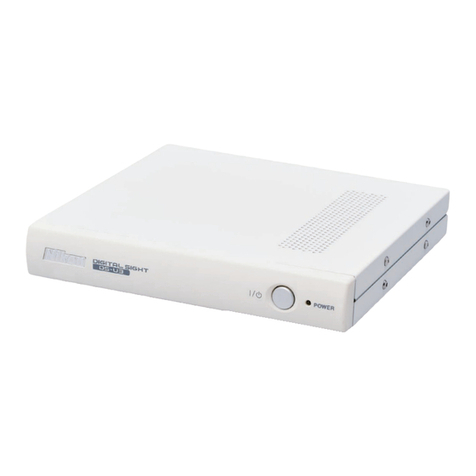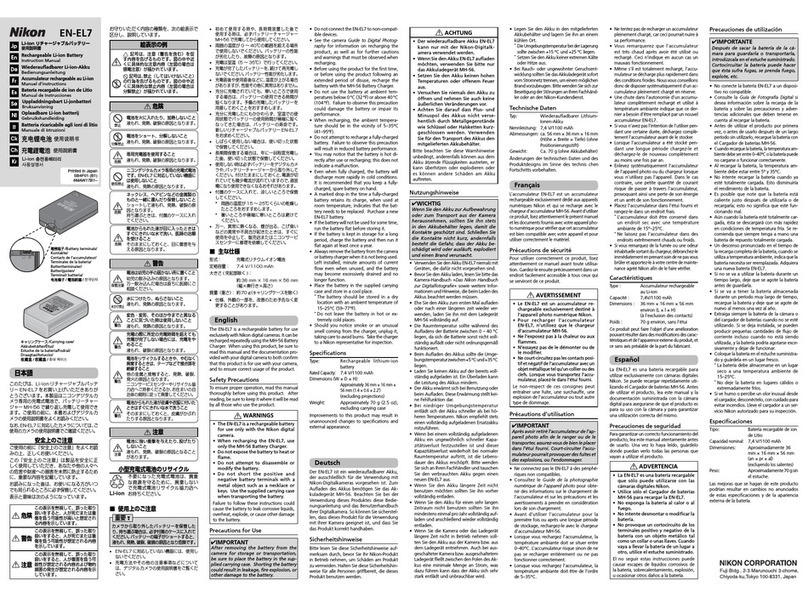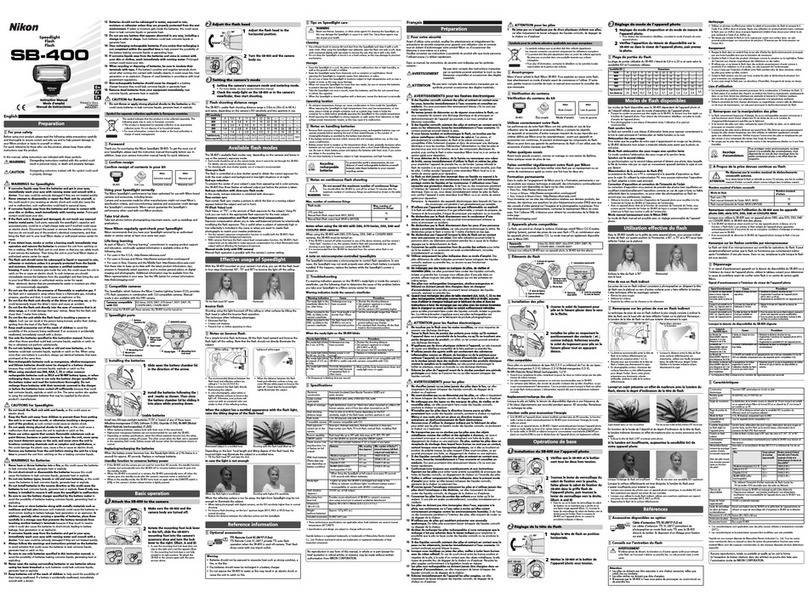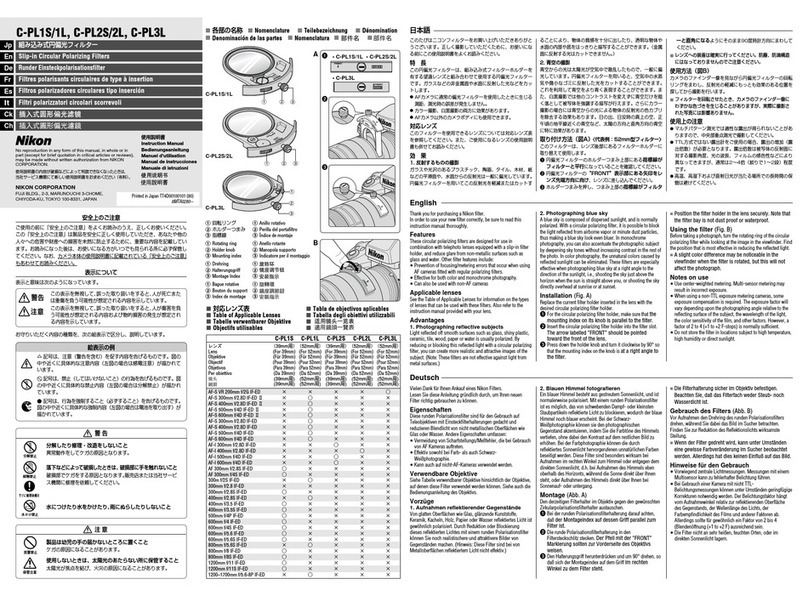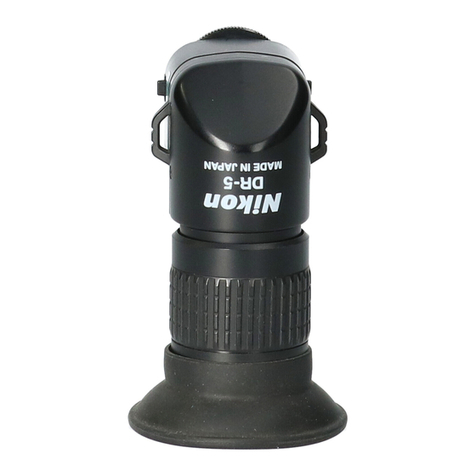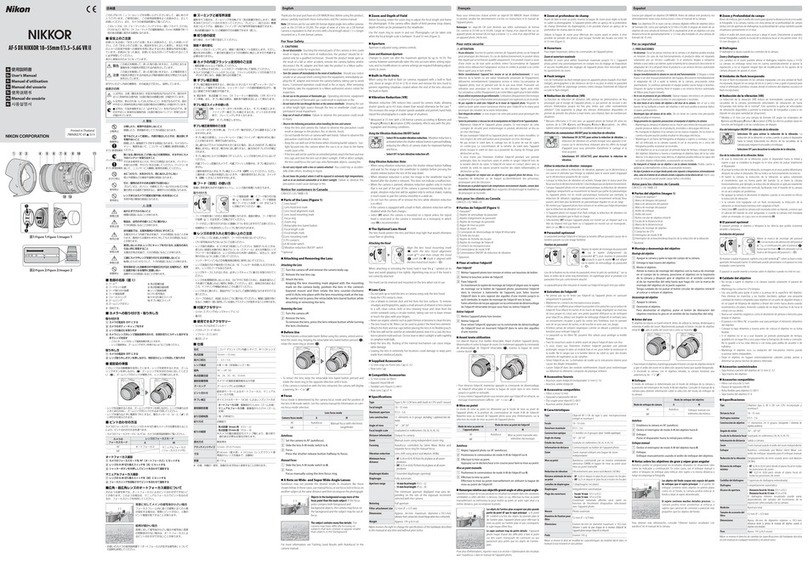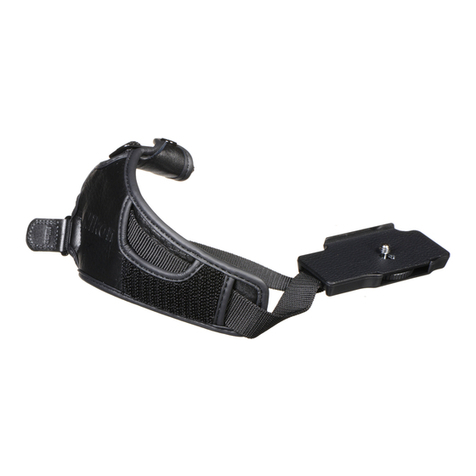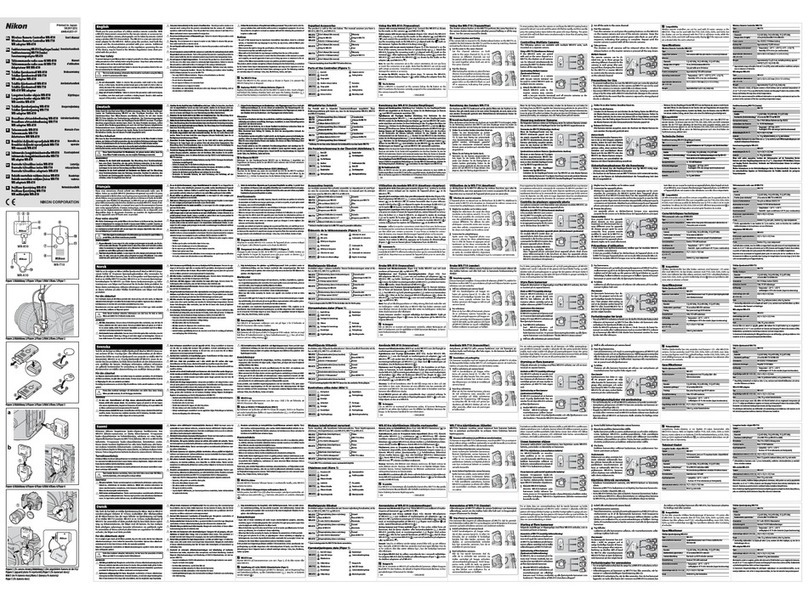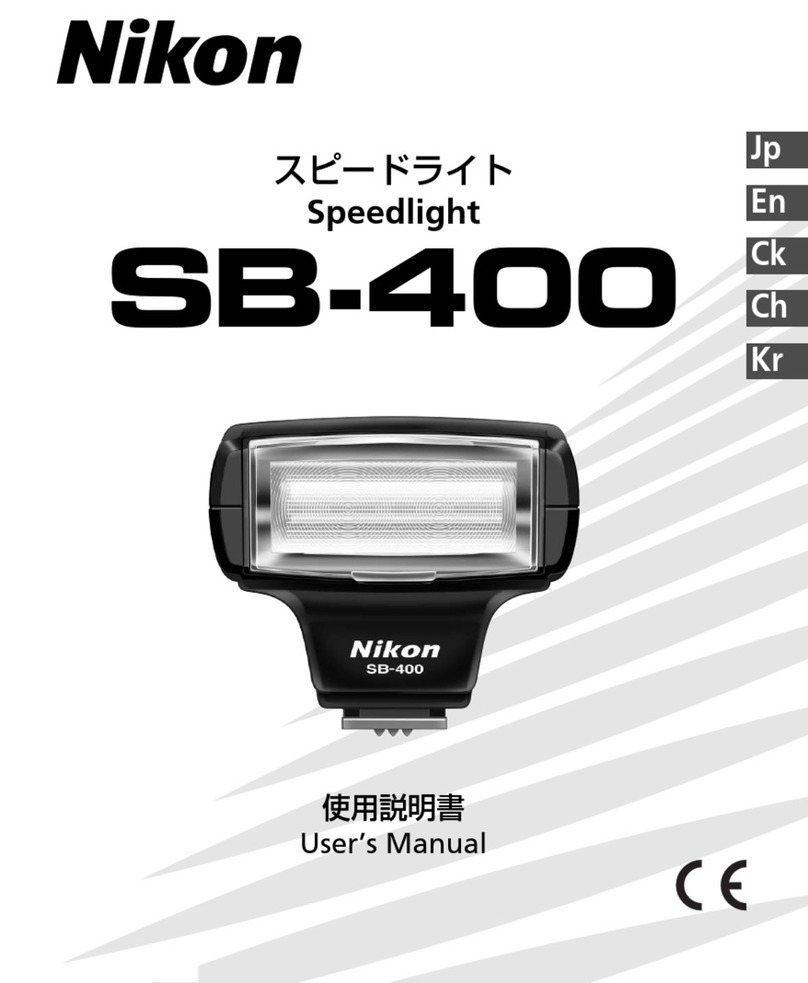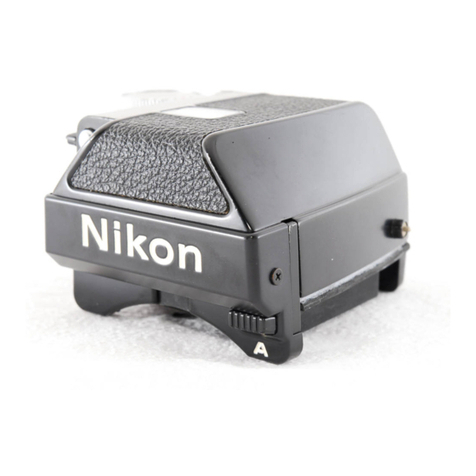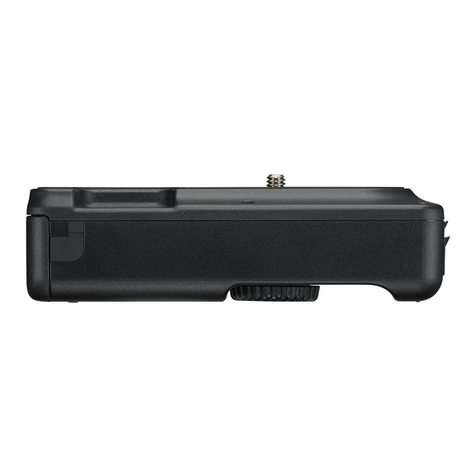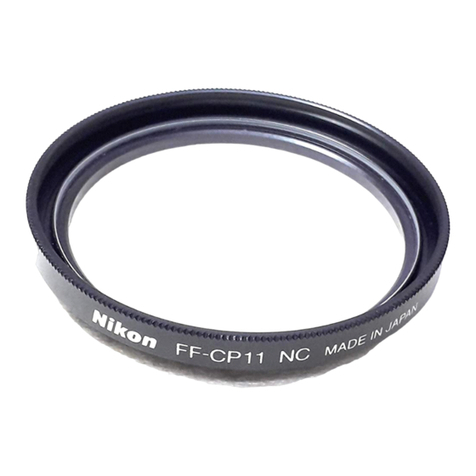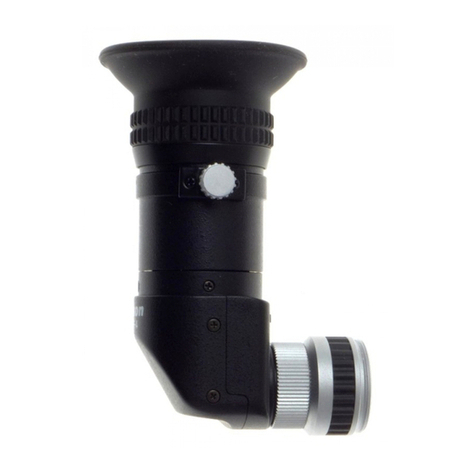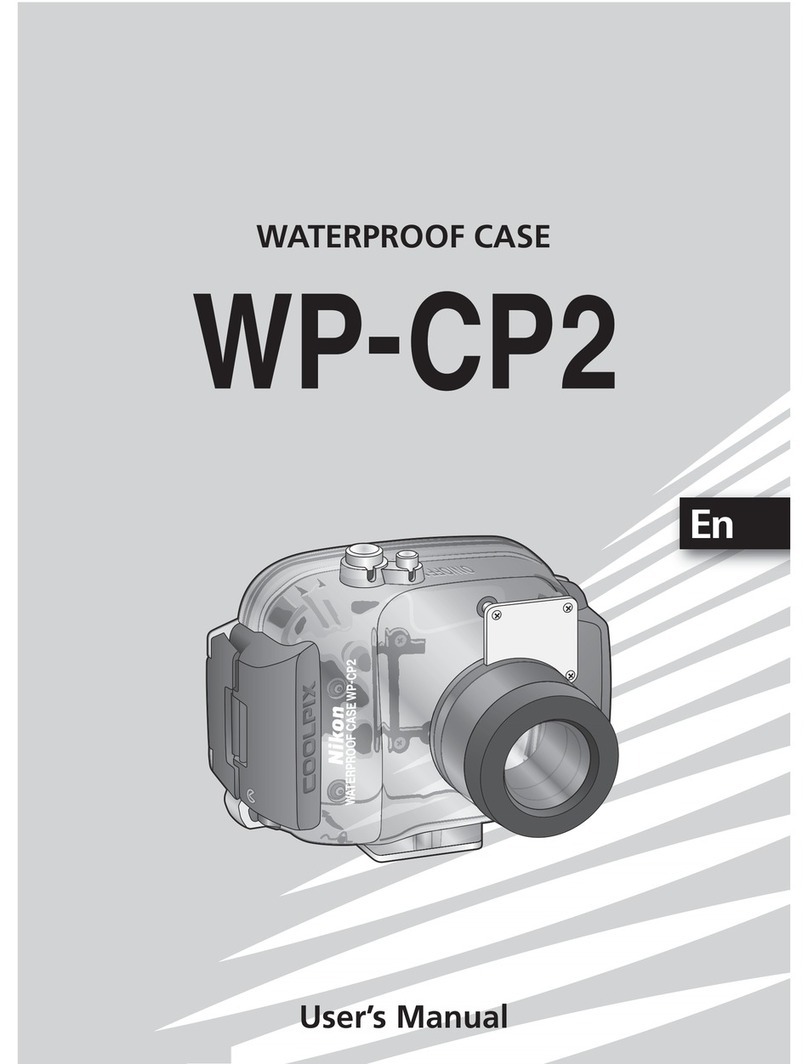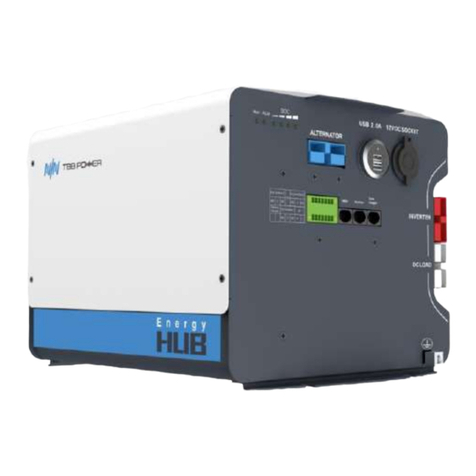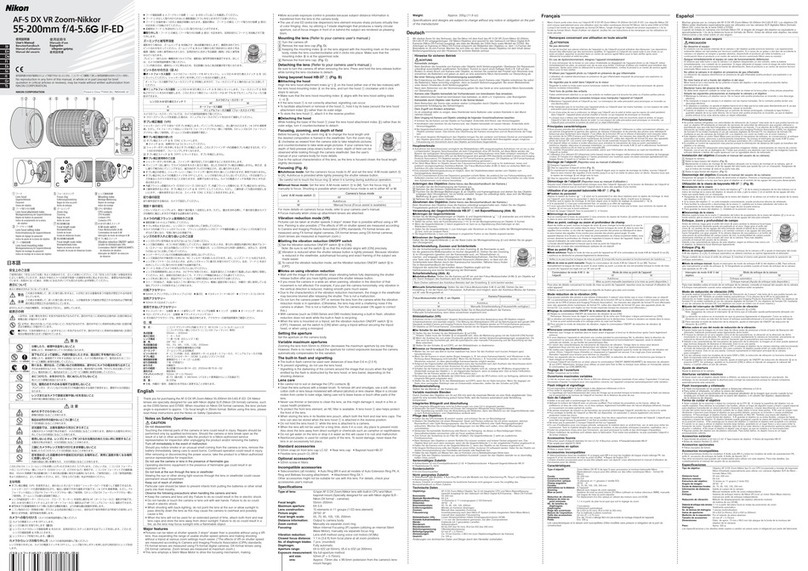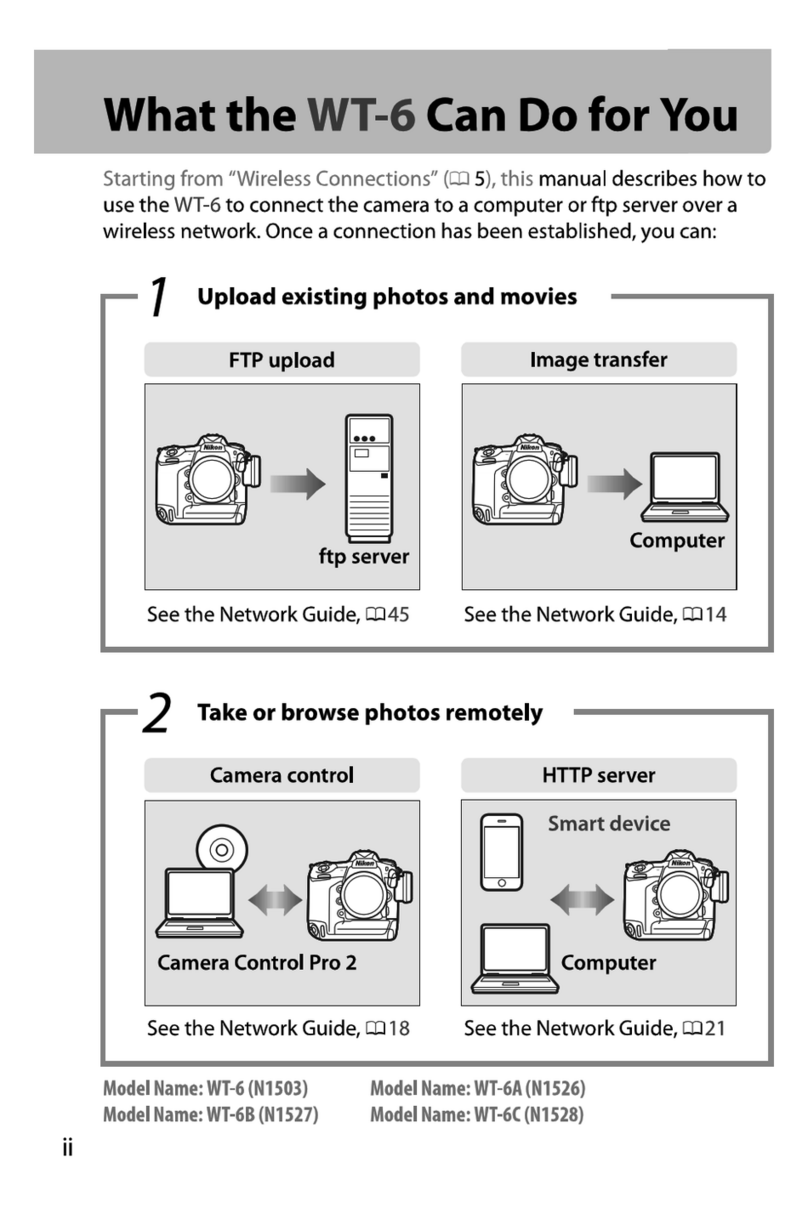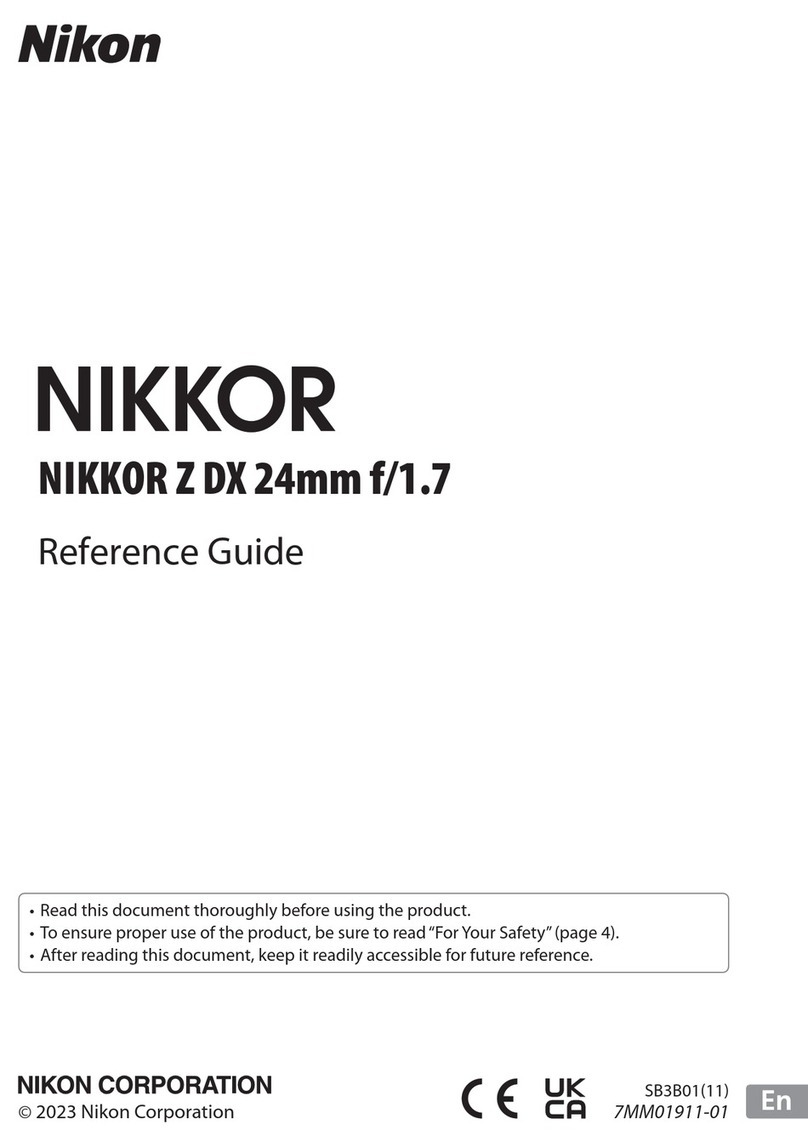
AF-S NIKKOR 80-400mm f/4.5-5.6G ED VR
Nano Crystal Coat
■
Depth of fie
ld (Metric)
■
Profondeur de
champ
■景深
(m)
• Focus distance
• Distance de mise au
point
• 对焦距离
• Depth of eld
• Profondeur de
champ
• 景深
• Reproduction ratio
• Rapport de
reproduction
• 成像率
[f=80mm]
f/4.5 f/5.6 f/8 f/11 f/16 f/22 f/32
1.8
1.69 – 1.82 1.67 – 1.84 1.64 – 1.88 1.60 – 1.94 1.55 – 2.03 1.48 – 2.18 1.39 – 2.43 1/20.6
2.5
2.37 – 2.65 2.34 – 2.69 2.28 – 2.77 2.20 – 2.91 2.10 – 3.12 1.97 – 3.49 1.82 – 4.20 1/29.7
43.67 – 4.40 3.60 – 4.50 3.46 – 4.76 3.28 – 5.17 3.05 – 5.89 2.79 – 7.36 2.49 – 11.52 1/48.1
65.29 – 6.95 5.14 – 7.22 4.86 – 7.89 4.50 – 9.09 4.09 – 11.62 3.62 – 19.29 3.13 – 387.52 1/72.6
97.48 – 11.32 7.19 – 12.07 6.64 – 14.08 6.00 – 18.45 5.28 – 33.09 4.53 – ∞ 3.78 – ∞
1/109.4
12 9.44 – 16.53 8.98 – 18.18 8.14 – 23.17 7.20 – 38.00 6.19 – 436.05 5.17 – ∞ 4.21 – ∞
1/146.2
20 13.76 – 36.89 12.81 – 46.28
11.16 – 102.65
9.45 – ∞ 7.78 – ∞ 6.24 – ∞ 4.89 – ∞
1/244.2
40
20.96 – 483.45
18.83 – ∞ 15.47 – ∞ 12.37 – ∞ 9.65 – ∞ 7.38 – ∞ 5.57 – ∞
1/489.3
∞43.96 – ∞ 35.53 – ∞ 25.18 – ∞ 17.87 – ∞ 12.70 – ∞ 9.04 – ∞ 6.45 – ∞ 1/∞
[f=105mm]
f/4.8 f/5.6 f/8 f/11 f/16 f/22 f/32
1.8
1.71 – 1.80 1.70 – 1.81 1.68 – 1.83 1.65 – 1.87 1.61 – 1.92 1.56 – 2.00 1.50 – 2.13 1/16.4
2.5
2.41 – 2.60 2.40 – 2.61 2.36 – 2.66 2.30 – 2.74 2.23 – 2.86 2.13 – 3.04 2.02 – 3.34 1/23.5
43.78 – 4.25 3.74 – 4.30 3.65 – 4.44 3.52 – 4.65 3.35 – 4.99 3.14 – 5.56 2.89 – 6.67 1/37.8
65.52 – 6.57 5.44 – 6.69 5.24 – 7.03 4.98 – 7.58 4.65 – 8.52 4.27 – 10.35 3.82 – 14.93 1/56.8
97.97 – 10.35 7.80 – 10.65 7.39 – 11.54 6.89 – 13.08 6.28 – 16.14 5.59 – 24.23 4.85 – 85.67 1/85.4
12
10.23 – 14.53
9.96 – 15.13 9.31 – 16.97 8.52 – 20.52 7.61 – 29.20 6.63 – 73.64 5.61 – ∞
1/114.0
20
15.53 – 28.16 14.91 – 30.49 13.49 – 39.02 11.90 – 64.73
10.21 – ∞ 8.51 – ∞ 6.90 – ∞
1/190.2
40
25.39 – 95.04
23.78 – 127.97
20.38 – ∞ 16.96 – ∞ 13.72 – ∞ 10.82 – ∞ 8.35 – ∞
1/380.7
∞69.60 – ∞ 58.71 – ∞ 41.57 – ∞ 29.46 – ∞ 20.90 – ∞ 14.85 – ∞ 10.57 – ∞ 1/∞
[f=135mm]
f/5 f/5.6 f/8 f/11 f/16 f/22 f/32 f/36
1.8
1.72 – 1.78 1.72 – 1.79 1.70 – 1.80 1.68 – 1.82 1.66 – 1.86 1.62 – 1.90 1.57 – 1.98 1.56 – 2.01 1/13.1
2.5
2.44 – 2.56 2.43 – 2.57 2.41 – 2.60 2.37 – 2.65 2.32 – 2.71 2.25 – 2.82 2.17 – 2.97 2.13 – 3.05 1/18.7
43.85 – 4.16 3.83 – 4.18 3.77 – 4.26 3.68 – 4.38 3.57 – 4.56 3.42 – 4.85 3.22 – 5.32 3.15 – 5.55 1/29.8
65.68 – 6.36 5.64 – 6.41 5.50 – 6.60 5.32 – 6.89 5.09 – 7.34 4.79 – 8.09 4.43 – 9.49
4.29 – 10.23
1/44.6
98.30 – 9.83 8.22 – 9.95
7.94 – 10.40 7.57 – 11.12 7.11 – 12.34 6.54 – 14.61 5.89 – 19.82 5.65 – 23.31
1/66.8
12
10.80 – 13.51 10.66 – 13.74 10.19 – 14.61
9.60 – 16.07 8.87 – 18.73 8.01 – 24.47 7.05 – 43.51 6.72 – 64.69
1/89.0
20
16.89 – 24.54 16.55 – 25.29 15.46 – 28.42 14.13 – 34.47 12.61 – 49.40
10.95 – 128.54
9.25 – ∞ 8.69 – ∞
1/148.3
40
29.27 – 63.34 28.28 – 68.58 25.23 – 97.60
21.90 – 243.92
18.46 – ∞ 15.13 – ∞ 12.07 – ∞ 11.13 – ∞
1/296.5
∞109.57 – ∞ 96.93 – ∞ 68.61 – ∞ 48.59 – ∞ 34.44 – ∞ 24.43 – ∞ 17.35 – ∞ 15.49 – ∞ 1/∞
[f=200mm]
f/5.3 f/5.6 f/8 f/11 f/16 f/22 f/32 f/38
1.8
1.73 – 1.77 1.73 – 1.77 1.72 – 1.78 1.71 – 1.79 1.70 – 1.80 1.68 – 1.83 1.65 – 1.86 1.63 – 1.89 1/9.4
2.5
2.47 – 2.53 2.47 – 2.54 2.45 – 2.55 2.43 – 2.57 2.40 – 2.60 2.37 – 2.65 2.32 – 2.72 2.29 – 2.77 1/13.2
43.92 – 4.08 3.92 – 4.09 3.88 – 4.12 3.84 – 4.18 3.78 – 4.26 3.69 – 4.37 3.58 – 4.55 3.51 – 4.67 1/20.7
65.83 – 6.18 5.82 – 6.19 5.75 – 6.27 5.66 – 6.39 5.53 – 6.57 5.35 – 6.84 5.12 – 7.27 4.99 – 7.58 1/30.7
98.63 – 9.40 8.62 – 9.42 8.47 – 9.61 8.26 – 9.89
8.00 – 10.31 7.64 – 10.98 7.20 – 12.09
6.94 – 12.94
1/45.7
12
11.37 – 12.71 11.33 – 12.75 11.08 – 13.09 10.74 – 13.61 10.30 – 14.41
9.73 – 15.73 9.03 – 18.08
8.63 – 20.02
1/60.7
20
18.32 – 22.02 18.24 – 22.14 17.60 – 23.17 16.77 – 24.81 15.73 – 27.56 14.46 – 32.73 12.99 – 44.62 12.19 – 58.41
1/100.7
40
33.87 – 48.88 33.60 – 49.45 31.52 – 54.83 28.98 – 64.83 26.03 – 87.43
22.76 – 173.08
19.35 – ∞ 17.64 – ∞
1/200.7
∞223.49 – ∞ 212.56 – ∞ 150.40 – ∞ 106.46 – ∞ 75.40 – ∞ 53.43 – ∞ 37.90 – ∞ 31.93 – ∞ 1/∞
[f=300mm]
f/5.6 f/8 f/11 f/16 f/22 f/32 f/40
1.8
1.74 – 1.76 1.74 – 1.76 1.73 – 1.77 1.72 – 1.78 1.71 – 1.79 1.69 – 1.81 1.68 – 1.83 1/6.9
2.5
2.48 – 2.52 2.47 – 2.53 2.46 – 2.54 2.45 – 2.55 2.43 – 2.58 2.40 – 2.61 2.38 – 2.64 1/9.4
43.96 – 4.04 3.94 – 4.06 3.92 – 4.09 3.89 – 4.12 3.84 – 4.18 3.78 – 4.25 3.73 – 4.33 1/14.4
65.91 – 6.09 5.88 – 6.13 5.83 – 6.18 5.76 – 6.26 5.67 – 6.37 5.55 – 6.55 5.44 – 6.71 1/21.1
98.82 – 9.19 8.74 – 9.27 8.64 – 9.39 8.50 – 9.57 8.31 – 9.82 8.06 – 10.22 7.85 – 10.59 1/31.1
12
11.68 – 12.34 11.56 – 12.48 11.38 – 12.69 11.15 – 13.00 10.83 – 13.47 10.42 – 14.20 10.07 – 14.92
1/41.1
20
19.16 – 20.92 18.83 – 21.33 18.39 – 21.93 17.80 – 22.85 17.03 – 24.29 16.05 – 26.68 15.28 – 29.25
1/67.7
40
36.83 – 43.78 35.68 – 45.53 34.16 – 48.31 32.22 – 52.88 29.83 – 61.08 27.01 – 78.34
24.93 – 104.73
1/134.4
∞475.50 – ∞ 338.24 – ∞ 239.38 – ∞ 169.49 – ∞ 120.06 – ∞ 85.11 – ∞ 67.71 – ∞ 1/∞
[f=400mm]
f/5.6 f/8 f/11 f/16 f/22 f/32 f/40
1.8
1.74 – 1.76 1.74 – 1.76 1.74 – 1.76 1.73 – 1.77 1.72 – 1.78 1.71 – 1.79 1.70 – 1.80 1/5.7
2.5
2.49 – 2.51 2.48 – 2.52 2.48 – 2.53 2.47 – 2.54 2.45 – 2.55 2.43 – 2.57 2.42 – 2.59 1/7.6
43.97 – 4.03 3.96 – 4.04 3.95 – 4.05 3.93 – 4.08 3.90 – 4.11 3.85 – 4.16 3.82 – 4.20 1/11.5
65.94 – 6.06 5.92 – 6.08 5.89 – 6.11 5.85 – 6.16 5.79 – 6.23 5.71 – 6.33 5.64 – 6.42 1/16.5
98.88 – 9.12 8.84 – 9.17 8.78 – 9.24 8.69 – 9.34 8.57 – 9.49 8.40 – 9.71 8.26 – 9.91 1/24.2
12
11.80 – 12.21 11.73 – 12.29 11.62 – 12.41 11.47 – 12.59 11.26 – 12.85 10.99 – 13.24 10.75 – 13.61
1/31.8
20
19.47 – 20.56 19.29 – 20.77 19.01 – 21.11 18.62 – 21.61 18.11 – 22.36 17.43 – 23.52 16.88 – 24.66
1/52.2
40
38.01 – 42.22 37.33 – 43.10 36.32 – 44.53 35.00 – 46.74 33.28 – 50.26 31.13 – 56.30 29.46 – 63.05
1/103.3
∞789.34 – ∞ 577.42 – ∞ 408.64 – ∞ 289.30 – ∞ 204.92 – ∞ 145.24 – ∞ 115.53 – ∞ 1/∞
• Unlike other lenses, the focal length of internal focus (IF) lenses decreases with
focus distance.
• Contrairement aux autres objectifs, la focale des objectifs à mise au point
interne (IF) diminue avec la distance de mise au point.
• 与其它镜头不同,内部对焦(IF)镜头的焦距随着对焦距离的缩短而减小。
■Depth of field (Imperial) (ft)
Focus distance Depth of field Reproduction ratio
[f=80mm]
f/4.5 f/5.6 f/8 f/11 f/16 f/22 f/32
76 ft 8 ⁄ in. –
7 ft 4 ⁄ in.
6 ft 7 ⁄ in. –
7 ft 5 ⁄ in.
6 ft 5 ⁄ in. –
7 ft 7 ⁄ in.
6 ft 3 ⁄ in. –
7 ft 11 ⁄ in.
6 ft ⁄ in. –
8 ft 5 ⁄ in.
5 ft 8 ⁄ in. –
9 ft 2 ⁄ in.
5 ft 3 ⁄ in. –
10 ft 7 ⁄ in. 1/25.3
15
13 ft 7 ⁄ in. –
16 ft 8 ⁄ in.
13 ft 3 ⁄ in. –
17 ft 2 ⁄ in.
12 ft 8 ⁄ in. –
18 ft 4 ⁄ in.
11 ft 11 ⁄ in. –
20 ft 2 ⁄ in.
11 ft ⁄ in. –
23 ft 8 ⁄ in.
10 ft ⁄ in. –
31 ft 5 ⁄ in.
8 ft 10 ⁄ in. –
59 ft 5 ⁄ in.
1/55.1
25
21 ft 3 ⁄ in. –
30 ft 3 in.
20 ft 7 ⁄ in. –
31 ft 10 ⁄ in.
19 ft 2 ⁄ in. –
35 ft 11 ⁄ in.
17 ft 6 ⁄ in. –
44 ft 1 ⁄ in.
15 ft 8 ⁄ in. –
65 ft ⁄ in.
13 ft 7 ⁄ in. –
203 ft 1 ⁄ in.
11 ft 6 ⁄ in. –
∞
1/92.5
70
47 ft 2 ⁄ in. –
136 ft 10 ⁄ in.
43 ft 9 ⁄ in. –
177 ft 7 ⁄ in.
37 ft 11 ⁄ in. –
496 ft 10 ⁄ in.
31 ft 11 ⁄ in. –
∞
26 ft 2 ⁄ in. –
∞
20 ft 10 ⁄ in. –
∞
16 ft 3 ⁄ in. –
∞
1/260.6
∞
144 ft 2 ⁄ in. –
∞
116 ft 6 ⁄ in. –
∞
82 ft 7 ⁄ in. –
∞
58 ft 7 ⁄ in. –
∞
41 ft 7 ⁄ in. –
∞
29 ft 7 ⁄ in. –
∞
21 ft 2 ⁄ in. –
∞
1/∞
[f=105mm]
f/4.8 f/5.6 f/8 f/11 f/16 f/22 f/32
76 ft 9 ⁄ in. –
7 ft 2 ⁄ in.
6 ft 9 in. –
7 ft 3 ⁄ in.
6 ft 7 ⁄ in. –
7 ft 4 ⁄ in.
6 ft 6 ⁄ in. –
7 ft 6 ⁄ in.
6 ft 4 ⁄ in. –
7 ft 9 ⁄ in.
6 ft 1 ⁄ in. –
8 ft 3 in.
5 ft 9 ⁄ in. –
8 ft 11 ⁄ in. 1/20.0
15 14 ft ⁄ in. –
16 ft ⁄ in.
13 ft 10 ⁄ in. –
16 ft 3 ⁄ in.
13 ft 6 in. –
16 ft 10 ⁄ in.
12 ft 11 ⁄ in. –
17 ft 10 ⁄ in.
12 ft 3 ⁄ in. –
19 ft 4 ⁄ in.
11 ft 5 ⁄ in. –
22 ft 1 ⁄ in.
10 ft 5 ⁄ in. –
27 ft 7 ⁄in.
1/43.2
25
22 ft 6 ⁄ in. –
28 ft 1 ⁄ in.
22 ft 1 ⁄ in. –
28 ft 9 ⁄in.
21 ft 1 ⁄ in. –
30 ft 8 ⁄ in.
19 ft 10 ⁄ in. –
33 ft 11 ⁄ in.
18 ft 3 ⁄ in. –
39 ft 11 ⁄ in.
16 ft 5 ⁄ in. –
53 ft 5 ⁄ in.
14 ft 5 ⁄ in. –
103 ft 5 ⁄ in.
1/72.3
70
53 ft 6 ⁄ in. –
101 ft 3 ⁄ in.
51 ft 3 ⁄ in. –
110 ft 6 ⁄ in.
46 ft 2 ⁄ in. –
145 ft 9 ⁄ in.
40 ft 6 ⁄ in. –
266 ft 2 ⁄ in.
34 ft 7 ⁄ in. –
∞
28 ft 8 ⁄ in. –
∞
23 ft 1 ⁄ in. –
∞
1/202.9
∞
228 ft 4 ⁄ in. –
∞
192 ft 7 ⁄ in. –
∞
136 ft 4 ⁄ in. –
∞
96 ft 8 ⁄ in. –
∞
68 ft 6 ⁄ in. –
∞
48 ft 8 ⁄ in. –
∞
34 ft 7 ⁄ in. –
∞
1/∞
[f=135mm]
f/5 f/5.6 f/8 f/11 f/16 f/22 f/32 f/36
7
6 ft 10 ⁄ in. –
7 ft 1 ⁄ in.
6 ft 10 ⁄ in. –
7 ft 2 ⁄ in.
6 ft 9 ⁄ in. –
7 ft 3 in.
6 ft 8 ⁄ in. –
7 ft 4 ⁄ in.
6 ft 6 ⁄ in. –
7 ft 6 ⁄ in.
6 ft 4 ⁄ in. –
7 ft 9 in.
6 ft 2 ⁄ in. –
8 ft 1 ⁄ in.
6 ft 1 ⁄ in. –
8 ft 3 ⁄ in.
1/16.0
15
14 ft 4 ⁄ in. –
15 ft 8 ⁄ in.
14 ft 3 ⁄ in. –
15 ft 9 ⁄ in.
14 ft ⁄ in. –
16 ft 1 ⁄ in.
13 ft 7 ⁄ in. –
16 ft 7 ⁄ in.
13 ft 2 ⁄ in. –
17 ft 5 ⁄ in.
12 ft 6 ⁄ in. –
18 ft 8 ⁄ in.
11 ft 9 ⁄ in. –
20 ft 10 ⁄ in.
11 ft 5 ⁄ in. –
21 ft 11 ⁄ in.
1/34.0
25
23 ft 4 ⁄ in. –
26 ft 11 ⁄ in.
23 ft 1 ⁄in.–
27 ft 2 ⁄ in.
22 ft 5 ⁄ in. –
28 ft 2 ⁄ in.
21 ft 6 ⁄ in. –
29 ft 10 ⁄ in.
20 ft 4 ⁄in.–
32 ft 5 ⁄ in.
18 ft 11 ⁄in.–
37 ft 1 ⁄ in.
17 ft 3 in. –
46 ft 7 ⁄ in.
16 ft 7 ⁄ in. –
52 ft 3 ⁄ in.
1/56.6
70
58 ft 6 ⁄ in. –
87 ft 2 ⁄ in.
57 ft 3 ⁄ in. –
90 ft 1 ⁄ in.
53 ft 3 ⁄ in. –
102 ft 4 ⁄ in.
48 ft 6 ⁄ in. –
126 ft 8 ⁄ in.
43 ft 1 ⁄ in. –
∞
37 ft 2 ⁄ in. –
∞
31 ft 3 ⁄ in. –
∞
29 ft 3 ⁄ in. –
∞
1/158.2
∞
359 ft 6 in. –
∞
318 ft ⁄ in. –
∞
225 ft 1 ⁄ in. –
∞
159 ft 5 ⁄ in. –
∞
112 ft 11 ⁄ in. –
∞
80 ft 1 ⁄ in. –
∞
56 ft 11 ⁄ in. –
∞
50 ft 9 ⁄ in. –
∞
1/∞
[f=200mm]
f/5.3 f/5.6 f/8 f/11 f/16 f/22 f/32 f/38
7
6 ft 11 ⁄ in. –
7 ft ⁄ in.
6 ft 10 ⁄ in. –
7 ft 1 ⁄ in.
6 ft 10 ⁄ in. –
7 ft 1 ⁄ in.
6 ft 9 ⁄ in. –
7 ft 2 ⁄ in.
6 ft 9 ⁄ in. –
7 ft 3 ⁄ in.
6 ft 8 ⁄ in. –
7 ft 4 ⁄ in.
6 ft 6 ⁄ in. –
7 ft 6 ⁄ in.
6 ft 5 ⁄ in. –
7 ft 7 ⁄ in.
1/11.4
15
14 ft 8 ⁄ in. –
15 ft 4 ⁄ in.
14 ft 7 ⁄ in. –
15 ft 4 ⁄ in.
14 ft 6 ⁄ in. –
15 ft 6 ⁄ in.
14 ft 3 ⁄ in. –
15 ft 9 in.
14 ft ⁄ in. –
16 ft 1 ⁄ in.
13 ft 8 ⁄ in. –
16 ft 7 ⁄ in.
13 ft 2 ⁄ in. –
17 ft 4 ⁄ in.
12 ft 11 ⁄ in.–
17 ft 10 ⁄ in.
1/23.5
25
24 ft 1 ⁄ in. –
25 ft 11 ⁄ in.
24 ft ⁄ in. –
25 ft 11 ⁄ in.
23 ft 8 ⁄ in. –
26 ft 5 ⁄ in.
23 ft 2 ⁄ in. –
27 ft ⁄ in.
22 ft 6 ⁄ in. –
28 ft ⁄ in.
21 ft 8 ⁄ in. –
29 ft 6 ⁄ in.
20 ft 7 ⁄ in. –
31 ft 11 ⁄ in.
19 ft 11 ⁄ in.–
33 ft 9 ⁄ in.
1/38.8
70
63 ft 9 ⁄ in. –
77 ft 7 ⁄ in.
63 ft 5 ⁄ in. –
78 ft ⁄ in.
61 ft 1 ⁄ in. –
81 ft 11 ⁄ in.
58 ft 1 ⁄ in. –
88 ft 2 ⁄ in.
54 ft 3 ⁄ in. –
98 ft 10 ⁄ in.
49 ft 8 ⁄ in. –
119 ft 6 ⁄ in.
44 ft 5 ⁄ in. –
169 ft 9 ⁄ in.
41 ft 7 ⁄ in. –
233 ft 8 ⁄ in.
1/107.4
∞
733 ft 2 ⁄ in. –
∞
697 ft 4 ⁄ in. –
∞
493 ft 5 ⁄ in. –
∞
349 ft 3 ⁄ in. –
∞
247 ft 4 ⁄ in. –
∞
175 ft 3 ⁄ in. –
∞
124 ft 4 ⁄ in. –
∞
104 ft 9 ⁄ in. –
∞
1/∞
[f=300mm]
f/5.6 f/8 f/11 f/16 f/22 f/32 f/40
7
6 ft 11 ⁄ in. –
7 ft ⁄ in.
6 ft 11 ⁄ in. –
7 ft ⁄ in.
6 ft 10 ⁄ in. –
7 ft 1 ⁄ in.
6 ft 10 ⁄ in. –
7 ft 1 ⁄ in.
6 ft 9 ⁄ in. –
7 ft 2 ⁄ in.
6 ft 9 in. –
7 ft 3 ⁄ in.
6 ft 8 ⁄ in. –
7 ft 4 ⁄ in.
1/8.2
15
14 ft 9 ⁄ in. –
15 ft 2 ⁄ in.
14 ft 9 ⁄ in. –
15 ft 3 in.
14 ft 7 ⁄ in. –
15 ft 4 ⁄ in.
14 ft 6 ⁄ in. –
15 ft 6 ⁄ in.
14 ft 4 ⁄ in. –
15 ft 8 ⁄ in.
14 ft ⁄ in. –
16 ft ⁄ in.
13 ft 10 ⁄ in. –
16 ft 4 ⁄ in.
1/16.3
25
24 ft 6 ⁄ in. –
25 ft 5 ⁄ in.
24 ft 4 ⁄ in. –
25 ft 7 ⁄ in.
24 ft 1 ⁄ in. –
25 ft 11 ⁄ in.
23 ft 9 ⁄ in. –
26 ft 4 ⁄ in.
23 ft 3 ⁄ in. –
26 ft 11 ⁄ in.
22 ft 8 ⁄ in. –
27 ft 10 ⁄ in.
22 ft 2 ⁄ in. –
28 ft 8 ⁄ in.
1/26.5
70
66 ft 10 ⁄ in. –
73 ft 5 ⁄ in.
65 ft 8 ⁄ in. –
74 ft 11 ⁄ in.
64 ft ⁄ in. –
77 ft 2 ⁄in.
61 ft 10 ⁄ in. –
80 ft 8 ⁄ in.
59 ft ⁄ in. –
86 ft 2 ⁄in.
55 ft 5 ⁄ in. –
95 ft 4 ⁄ in.
52 ft 8 ⁄ in. –
105 ft 5 ⁄ in.
1/72.2
∞
1560 ft ⁄ in. –
∞
1109 ft 8 ⁄ in. –
∞
785 ft 4 ⁄ in. –
∞
556 ft ⁄ in. –
∞
393 ft 10 ⁄ in. –
∞
279 ft 2 ⁄ in. –
∞
222 ft 1 ⁄ in. –
∞
1/∞
[f=400mm]
f/5.6 f/8 f/11 f/16 f/22 f/32 f/40
7
6 ft 11 ⁄ in. –
7 ft ⁄ in.
6 ft 11 ⁄ in. –
7 ft ⁄ in.
6 ft 11 ⁄ in. –
7 ft ⁄ in.
6 ft 10 ⁄ in. –
7 ft 1 ⁄ in.
6 ft 10 ⁄ in. –
7 ft 1 ⁄ in.
6 ft 9 ⁄ in. –
7 ft 2 ⁄ in.
6 ft 9 ⁄ in. –
7 ft 2 ⁄ in. 1/6.7
15
14 ft 10 ⁄ in. –
15 ft 1 ⁄ in.
14 ft 10 ⁄ in. –
15 ft 1 ⁄ in.
14 ft 9 ⁄ in. –
15 ft 2 ⁄ in.
14 ft 8 ⁄ in. –
15 ft 3 ⁄ in.
14 ft 6 ⁄ in. –
15 ft 5 ⁄ in.
14 ft 4 ⁄ in. –
15 ft 7 ⁄ in.
14 ft 3 ⁄ in. –
15 ft 10 ⁄ in.
1/12.9
25
24 ft 8 ⁄ in. –
25 ft 3 ⁄ in.
24 ft 7 ⁄ in. –
25 ft 4 ⁄ in.
24 ft 5 ⁄ in. –
25 ft 6 ⁄ in.
24 ft 2 ⁄ in. –
25 ft 9 ⁄ in.
23 ft 11 ⁄ in. –
26 ft 2 ⁄ in.
23 ft 6 ⁄ in. –
26 ft 8 ⁄ in.
23 ft 2 ⁄ in. –
27 ft 2 ⁄ in.
1/20.7
70 68 ft ⁄ in. –
72 ft ⁄ in.
67 ft 4 ⁄ in. –
72 ft 10 ⁄ in.
66 ft 3 ⁄ in. –
74 ft 1 ⁄ in.
64 ft 10 ⁄ in. –
76 ft ⁄ in.
63 ft ⁄ in. –
78 ft 10 ⁄ in.
60 ft 6 ⁄ in. –
83 ft 2 ⁄ in.
58 ft 6 in. –
87 ft 6 ⁄ in. 1/55.7
∞
2589 ft 8 ⁄ in. –
∞
1894 ft 5 ⁄ in. –
∞
1340 ft 8 ⁄ in. –
∞
949 ft 2 ⁄ in. –
∞
672 ft 3 ⁄ in. –
∞
476 ft 6 ⁄ in. –
∞
379 ft ⁄ in. –
∞
1/∞
• Unlike other lenses, the focal length of internal focus (IF) lenses decreases with
focus distance.
Figure 1/Figure 1/图1
Figure 2/Figure 2/图2
Thank you for your purchase of a NIKKOR lens. Before using this product, please
carefully read both these instructions and the camera manual.
Note: When mounted on a DX-format digital single-lens reflex camera such
as the D7000 or cameras in the D300 series, this lens has an angle of view of
20°– 4° and a focal length equivalent to 120– 600 mm (35 mm format).
For Your Safety
A
CAUTIONS
• Do not disassemble. Touching the internal parts of the camera or lens could result
in injury. In the event of malfunction, the product should be repaired only by
a qualified technician. Should the product break open as the result of a fall or
other accident, remove the camera battery and/or disconnect the AC adapter
and then take the product to a Nikon-authorized service center for inspection.
• Turn the camera o immediately in the event of malfunction. Should you notice
smoke or an unusual smell coming from the equipment, immediately unplug
the AC adapter and remove the camera battery, taking care to avoid burns.
Continued operation could result in fire or injury. After removing the battery,
take the equipment to a Nikon-authorized service center for inspection.
• Do not use in the presence of ammable gas. Operating electronic equipment in the
presence of flammable gas could result in explosion or fire.
• Do not look at the sun through the lens or the camera viewnder. Viewing the sun or
other bright light source through the lens or viewfinder could cause perma-
nent visual impairment.
• Keep out of reach of children. Failure to observe this precaution could result in
injury.
• Observe the following precautions when handling the lens and camera:
-Keep the lens and camera dry. Failure to observe this precaution could result
in fire or electric shock.
-Do not handle the lens or camera with wet hands. Failure to observe this
precaution could result in electric shock.
-Keep the sun well out of the frame when shooting backlit subjects. Sunlight
focused into the camera when the sun is in or close to the frame could cause
a fire.
-If the lens will not be used for an extended period, attach the front and rear
lens caps and store the lens out of direct sunlight. If left in direct sunlight, the
lens could focus the sun’s rays onto flammable objects, causing fire.
• Do not carry tripods with a lens or camera attached. You could trip or accidentally
strike others, resulting in injury.
• Do not leave the lens where it will be exposed to extremely high temperatures, such as
in an enclosed automobile or in direct sunlight. Failure to observe this precaution
could adversely affect the lens’internal parts, causing fire.
English
■
Parts of the Lens (Figure 1)
Parts of the Lens (Figure 1)
qLens hood mounting mark
wZoom ring
eFocal length scale
rFocal length mark
tFocus distance indicator
yFocus distance mark
uFocus ring
iLens rotation index
oLens mounting mark
!0 Rubber lens-mount gasket
!1 CPU contacts
!2 Focus-mode switch
!3 Focus limit switch
!4 Vibration reduction ON/OFF switch
!5 Vibration reduction mode switch
!6 Zoom lock switch
!7 Lens hood
!8 Lens hood alignment mark
!9 Lens hood lock mark
@0 Lens hood lock release button
@1 Tripod collar lock screw
@2 Position indices (90°)
@3 Tripod collar
■
Compatibility
Check marks (“✔“) indicate supported features, dashes (“—”) features that are
not supported. Some limitations may apply; see the camera manual for details.
Camera
Exposure
(shooting) mode
Function
P
4
S
A
M
AF
5
VR
6
Nikon digital single-lens reflex cameras, F6, F5,
F100, F/N80-series1, F/N75-series1, F/N65-series1 ✔✔✔✔ ✔ ✔
Pronea 600i/6i1, Pronea S2 ✔✔✔✔ ✔ —
F4-series, F90X/N90s1, F90-series/N901,
F70-series/N701 ✔✔—— ✔—
F60-series/N601, F/N55-series1, F50-series/N501,
F-401x/N50051, F-401s/N4004s1, F-401/N40041 ✔✔✔✔——
F-801s/N8008s1, F-801/N80081, F-601M/N60001 ✔✔——— —
F3AF, F-601/N60061, F-501/N20203, Nikon
manual focus cameras (excluding F-601M/N60001)—
1. N-series cameras and Pronea 6i sold in U. S. A. only.
2. Exposure mode M (manual) not available.
3. N2020 sold in U. S. A. and Canada only.
4. Includes AUTO and scene (Digital Vari-Program) modes.
5. Autofocus.
6. Vibration reduction.
■
Focus
Supported focus modes are shown in the following table (for information on
camera focus modes, see the camera manual).
Camera
Camera
focus mode
Lens focus mode
A/M
M/A
M
Nikon digital single-lens reflex
cameras, F6, F5, F4-series, F100,
F90X/N90s*, F90-series/N90*,
F/N80-series*, F/N75-series*,
F70-series/N70*, F/N65-series*,
Pronea 600i/6i*, Pronea S
AF
Autofocus
with manual
override
(AF priority)
Autofocus
with manual
override
(manual
priority)
Manual
focus with
electronic
rangender
MF
Manual focus (electronic range-
nder available with all cameras except
F-601M/N6000*)
F60-series/N60*,
F/N55-series*, F50-series/N50*,
F-801s/N8008s*, F-801/N8008*,
F-601M/N6000*, F-401x/N5005*,
F-401s/N4004s*, F-401/N4004*
AF, MF
* N-series cameras and Pronea 6i sold in U. S. A. only.
A/M and M/A Modes
• M/A: A
utofocus can be over-ridden by rotating the lens focus ring.
• A/M:
As above, except that the focus ring must be rotated farther
before the autofocus is over-ridden, preventing accidental chang-
es to focus caused by unintended operation of the focus ring.
z Slide the lens focus-mode switch to A/M or M/A.
xFocus.
If desired, autofocus can be over-ridden by rotating the lens focus
ring while the shutter-release button is pressed halfway (or, if the
camera is equipped with an AF-ON button, while the AF-ON button is
pressed). To refocus using autofocus, press the shutterrelease button
halfway or press the AF-ON button again.
The Focus Limit Switch
This switch determines the focus distance limits for autofocus.
• FULL: Select this option for subjects that may be closer than
6 m (19.69 ft).
• ∞–6 m: If your subject will always be at distance of at least 6 m
(19.69 ft), select this option for faster focusing.
■
Zoom and Depth of Field
Before focusing, rotate the zoom ring to adjust the focal length and frame the
photograph. If the camera offers depth-of-field preview (stop down), depth of
field can be previewed in the viewfinder.
Note: Focal length decreases as the focus distance shortens. Note that the focus
distance indicator is intended only as a guide and may not accurately show the
distance to the subject and may, due to depth of field or other factors, not show
∞ when the camera is focused on a distant object.
To lock the zoom ring, rotate it to the 80mm position and slide the zoom lock
switch to LOCK. This prevents the lens extending under its own weight while the
camera is being carried from place to place.
■
Aperture
Aperture is adjusted using camera controls.
Zoom and Maximum Aperture
Zoom and Maximum Aperture
Changes to zoom can alter the maximum aperture by up to ⁄EV. The camera
however automatically takes this into account when setting exposure, and no
modifications to camera settings are required following adjustments to zoom.
■
Built-in Flash Units
When using the built-in flash on cameras equipped with a built-in flash unit,
remove the lens hood to prevent vignetting (shadows created where the end of
the lens obscures the built-in flash).
■
Vibration Reduction (VR)
Vibration Reduction (VR)
Vibration reduction (VR) reduces blur caused by camera shake, allowing shutter
speeds up to 4.0 stops slower than would otherwise be the case (measured
at 400 mm with a D4 camera according to Camera and Imaging Products As-
sociation [CIPA] standards; effects vary with the photographer and shooting
conditions). This increases the range of shutter speeds available and permits
hand-held, tripod-free photography in a wide range of situations..
Using the Vibration Reduction ON/OFF Switch
Using the Vibration Reduction ON/OFF Switch
• Select ON toenable vibrationreduction. Vibration reduction is acti-
vated when the shutter-release button is pressed halfway, reduc-
ing the effects of camera shake for improved framing and focus.
• Select OFF to turn vibration reduction o.
Using the Vibration Reduction Mode Switch
Using the Vibration Reduction Mode Switch
The vibration reduction mode switch is used to select the vibration reduction
mode when vibration reduction is on.
• Select NORMAL to reduce the effects of vibration when pho-
tographing from a fixed position and in other situations with
comparatively little camera motion.
• Select ACTIVE to reduce the effects of vibration when shooting from a moving
vehicle, while walking, and in other situations with active camera motion.
Using Vibration Reduction: Notes
Using Vibration Reduction: Notes
• Slide the vibration reduction switch to OFF if the camera does not support
vibration reduction. Leaving vibration reduction on may greatly increase the
drain on the battery, particularly in the case of Pronea 600i/6i cameras.
• When using vibration reduction, press the shutter-release button halfway and
wait for the image in the viewfinder to stabilize before pressing the shutter-
release button the rest of the way down.
• When vibration reduction is active, the image in the viewfinder may be blurred
after the shutter is released. This does not indicate a malfunction.
• Slide the vibration reduction mode switch to NORMAL for panning shots. When
the camera is panned, vibration reduction applies only to motion that is not
part of the pan (if the camera is panned horizontally, for example, vibration
reduction will be applied only to vertical shake), making it much easier to pan
the camera smoothly in a wide arc.
• Do not turn the camera off or remove the lens while vibration reduction is in
effect. If power to the lens is cut while vibration reduction is on, the lens may
rattle when shaken. This is not a malfunction, and can be corrected by reat-
taching the lens and turning the camera on.
• If the camera is equipped with a built-in flash, vibration reduction will be dis-
abled while the flash charges.
• ON is generally recommended when the camera is mounted on a monopod or
a tripod with an unsecured head, although OFF may be preferred depending
shooting conditions and the type of tripod.
■
The Lens Hood
The lens hoods protect the lens and block stray light that would otherwise
cause flare or ghosting.
Attaching the Hood
Align the lens hood mounting mark (●)
with the lens hood alignment mark ( )
and then rotate the hood (w) until the ●
mark is aligned with the lens hood lock
mark (—).
When attaching or removing the hood, hold it near the symbol on its base
and avoid gripping it too tightly. Vignetting may occur if the hood is not cor-
rectly attached.
The hood can be reversed and mounted on the lens when not in use.
Detaching the Hood
Press the lens hood lock release button
(q), rotate the hood in the direction
shown by the arrow (w), and remove it as
shown (e).
■
Focusing Screens
The following cameras support a variety of focusing screens for use in different
situations.
Screen
Camera
A
B
C
E
EC-B
EC-E
G1
G2
G3
G4
J
L
M
U
F6
—— ——— —
F5+DP-30
(–0.5)
F5+DA-30
(+1.0)
(–0.5)
(+0.5)
: Recommended.
: Vignetting visible in viewfinder (photographs are not affected).
—: Not compatible with camera.
( ): Figures in parentheses give the exposure compensation for center-
weighted metering. Select “Other screen” for Custom Setting b6
(“Screen comp.”) when adjusting exposure compensation for the
F6; note that with screens other than B or E, “Other screen” must be
selected even when the value for exposure compensation is 0. Expo-
sure compensation for the F5 can be adjusted using Custom Setting
18; see the camera manual for details.
Empty cell: Not suited to use with this lens. Note that type M screens can how-
ever be used for photomicrography and macro photography at mag-
nifications of 1 : 1 or higher.
Note: The F5 supports matrix metering with A, B, E, EC-B/EC-E, J, and L focusing
screens only.
■
Using a Tripod (Figure 2)
Using a Tripod (Figure 2)
The lens is equipped with a detachable rotating tripod collar; when using a tripod,
attach it to the collar, not to the camera. To attach the collar to the lens:
zSlightly loosen the tripod collar lock screw (q).
xAlign the alignment mark on top of the lens with the mark on the
collar (w) and insert the lens into the collar.
c
Rotate the lens to the desired position (three positions are available at
90° intervals), stopping when the alignment mark on top of the lens is
aligned with the desired position mark on the collar (
e
), and then tighten
the tripod collar lock screw (
r
). Be sure the screw is fully tightened; if the
screw is not tight, the lens may fall from of the tripod collar.
Removing the Tripod Collar
Removing the Tripod Collar
zBeing careful not to remove the screw from its socket, loosen the
tripod collar lock screw until the collar rotates freely (t).
xAlign the alignment mark on top of the lens with the mark on the
collar (y) and remove the lens from the collar (u).
■
Lens Care
• Do not pick up or hold the lens or camera using only the lens hood.
• Keep the CPU contacts clean.
• Should the rubber lens-mount gasket be damaged, cease use immediately
and take the lens to a Nikon-authorized service center for repair.
• Use a blower to remove dust and lint from the lens surfaces. To remove smudges
and fingerprints, apply a small amount of ethanol or lens cleaner to a soft, clean
cotton cloth or lens-cleaning tissue and clean from the center outwards using a cir-
cular motion, taking care not to leave smears or touch the glass with your fingers.
• Never use organic solvents such as paint thinner or benzene to clean the lens.
• The lens hood or NC filters can be used to protect the front lens element.
• Attach the front and rear caps before placing the lens in its flexible pouch.
• If the lens will not be used for an extended period, store it in a cool, dry location to
prevent mold and rust. Do not store in direct sunlight or with naphtha or camphor
moth balls.
• Keep the lens dry. Rusting of the internal mechanism can cause irreparable
damage.
• Leaving the lens in extremely hot locations could damage or warp parts made
from reinforced plastic.
■
Supplied Accessories
• 77 mm snap-on Front Lens Cap LC-77
• Rear Lens Cap LF-4
• Bayonet Hood HB-65
• Flexible Lens Pouch CL-M2
■
Compatible Accessories
• 77 mm screw-on filters
• AF-I/AF-S Teleconverters TC-14E1/TC-14E II1/TC-17E II2/TC-20E2/TC-20E II2/
TC-20E III2
1 Autofocus is available only with cameras that offer f/8 support.
2 Autofocus not supported.
■
Specifications
Type Type G AF-S lens with built-in CPU and F mount
Focal length 80– 400 mm
Maximum aperture f/4.5– 5.6
Lens construction 20 elements in 12 groups (including 4 ED lens elements, 1 su-
per ED lens element, and lens elements with a Nano-Crystal coating)
Angle of view • Nikon lm SLR and FX-format D-SLR cameras:
30°10–6°10
• Nikon DX-format D-SLR cameras: 20°– 4°
Focal length scale Graduated in millimeters (80, 105, 135, 200, 300, 400)
Distance information Output to camera
Zoom Manual zoom using independent zoom ring
Focusing Nikon Internal Focusing (IF) System with autofocus
controlled by Silent Wave Motor and separate focus
ring for manual focus
Vibration reduction Lens shift using voice coil motors (VCMs)
Focusdistance indicator 1.5 m to infinity (∞)
Minimum focus distance • AF: 1.75 m (5.74 ft) from focal plane at all zoom posi-
tions
• MF: 1.5 m (4.92 ft) from focal plane at all zoom posi-
tions
Diaphragm blades 9 (rounded diaphragm opening)
Diaphragm Fully automatic
Aperture range • 80mmfocal length: f/4.5–32
• 400mmfocal length: f/5.6–40
The minimum aperture displayed may vary depending
on the size of the exposure increment selected with
the camera.
Metering Full aperture
Focus limit switch Two positions: FULL (∞ – 1.75 m) and ∞–6 m
Filter-attachment size 77 mm (P = 0.75 mm)
Dimensions Approx. 95.5 mm maximum diameter × 203 mm (dis-
tance from camera lens mount ange)
Weight Approx. 1570 g (3.5 lb), including tripod collar
Approx. 1480 g (3.3 lb) without tripod collar
Nikon reserves the right to change the specifications of the hardware described in
this manual at any time and without prior notice.
En
User’s Manual
Fr
Manuel d’utilisation
Ck
使用说明书
Ch
使用說明書
Id
Manual bagi Pengguna
Ar
Printed in Japan
SB2L01(6C)
7MAA896C-01▲
Français
Nous vous remercions d’avoir acheté un objectif NIKKOR. Avant de l’utiliser,
veuillez lire attentivement ces instructions et le manuel de l’appareil photo.
Remarque : Lorsqu’il est monté sur un appareil photo numérique reflex de
format DX comme le D7000 ou les appareils photo de la gamme D300, cet
objectif a un angle de champ de 20° – 4° et une focale équivalente à 120 –
600 mm (format 24× 36 mm).
Pour votre sécurité
A
ATTENTION
• Ne pas démonter. Toucher les parties internes de l’appareil photo ou de l’objectif
peut provoquer des blessures. En cas de dysfonctionnement, le produit devra
être réparé par un technicien qualifié uniquement. Si le produit s’ouvre à cause
d’une chute ou de tout autre accident, retirez l’accumulateur de l’appareil
photo et/ou débranchez l’adaptateur secteur et confiez le produit à un centre
Nikon agréé pour le faire vérifier.
• Mettre immédiatement l’appareil hors tension en cas de dysfonctionnement.
Si vous
détectez de la fumée ou une odeur inhabituelle provenant de l’équipement,
débranchez immédiatement l’adaptateur secteur et retirez l’accumulateur de
l’appareil photo, tout en prenant soin de ne pas vous brûler. Poursuivre son utilisation
peut provoquer un incendie ou des blessures. Après avoir retiré l’accumulateur,
confiez l’équipement à un centre Nikon agréé pour le faire vérifier.
• Ne pas utiliser en présence de gaz inammable. L’utilisation d’équipement
électronique en présence d’un gaz inflammable peut provoquer une
explosion ou un incendie.
• Ne pas regarder le soleil avec l’objectif ou le viseur de l’appareil photo. Regarder le
soleil ou toute autre source lumineuse intense avec l’objectif ou le viseur peut
provoquer des troubles de la vision irréversibles.
• Tenir éloigné des enfants. Le non-respect de cette précaution peut provoquer des
blessures.
• Suivre les précautions ci-dessous lors de la manipulation de l’objectif et de l’appareil photo :
-Tenir l’objectif et l’appareil photo au sec. Le non-respect de cette précaution
peut provoquer un incendie ou un choc électrique.
-Ne pas manipuler l’objectif ou l’appareil photo avec des mains mouillées. Le
non-respect de cette précaution peut provoquer un choc électrique.
-Ne pas inclure le soleil dans le cadrage lors de la prise de vue de sujets
en contre-jour. La concentration de la lumière du soleil dans l’appareil
photo lorsque le soleil est dans ou à proximité du champ de l’image peut
provoquer un incendie.
-Si vous n’avez pas l’intention d’utiliser l’objectif pendant une période
prolongée, fixez les bouchons avant et arrière et rangez l’objectif hors de
la lumière directe du soleil. Si l’objectif est laissé en contact direct avec la
lumière du soleil, les rayons peuvent toucher des objets inflammables,
provoquant ainsi un incendie.
• Nepasporteruntrépiedsur lequel un objectifoul’appareilphotoest xé.Vous risqueriez
de trébucher ou de frapper accidentellement des personnes, provoquant ainsi
des blessures.
• Ne pas laisser l’objectif là où il serait exposé à des températures élevées, comme une
voiture fermée ou à la lumière directe du soleil. Le non-respect de cette précaution
peut avoir des répercussions sur les parties internes de l’objectif, pouvant
provoquer un incendie.
■
Parties de l’objectif (Figure 1)
Parties de l’objectif (Figure 1)
qRepère de montage du parasoleil
wBague de zoom
eÉchelle des focales
rRepère de l’échelle des focales
tIndicateur de distance de mise
au point
yRepère de distance de mise au
point
uBague de mise au point
iRepère de rotation de l’objectif
oRepère de montage de l’objectif
!0 Joint en caoutchouc de la
monture d’objectif
!1 Contacts du microprocesseur
!2 Commutateur du mode de mise
au point
!3 Commutateur de la limite de mise au
point
!4 Commutateur ON/OFF de réduction
de vibration
!5 Commutateur du mode de réduction
de vibration
!6
Commutateur de verrouillage du zoom
!7 Parasoleil
!8 Repère d’alignement du parasoleil
!9 Repère de verrouillage du parasoleil
@0 Commande de déverrouillage du
parasoleil
@1 Vis de fixation du collier pour trépied
@2 Repères de position (90°)
@3 Collier pour trépied
■
Compatibilité
Les marques (« ✔») indiquent les fonctions prises en charge, les traits (« — »)
les fonctions non prises en charge. Certaines restrictions peuvent s’appliquer ;
consultez le manuel de l’appareil photo pour plus de détails.
Appareil photo
Mode d’exposition
(prise de vue)
Fonction
P
2
S
A
M
AF
3
VR
4
Reflex numériques Nikon, F6, F5, F100,
gamme F80, gamme F75, gamme F65 ✔✔✔✔✔ ✔
Pronea 600i, Pronea S 1 ✔✔✔✔✔ —
Gamme F4, F90X, gamme F90, gamme F70 ✔✔
—— ✔—
Gamme F60, gamme F55,
gamme F50, F-401x, F-401s, F-401 ✔✔✔✔——
F-801s, F-801, F-601M✔✔
—— — —
F3AF, F-601, F-501, appareils MF Nikon (sauf F-601
M
)—
1. Mode d’exposition M (manuel) non disponible.
2. Inclut les modes AUTO et scène (Vari-programme).
3. Autofocus.
4. Réduction de vibration.
■
Mise au point
Les modes de mise au point pris en charge sont indiqués dans le tableau
suivant (pour en savoir plus sur les modes de mise au point de l’appareil photo,
consultez le manuel de ce dernier).
Appareil photo
Mode de mise
au point de
l’appareil
photo
Mode de mise au point de l’objectif
Mode de mise au point de l’objectif
A/M
M/A
M
Reflex numériques Nikon,
F6, F5, gamme F4, F100,
F90X, gamme F90,
gamme F80, gamme F75,
gamme F70, gamme F65,
Pronea 600i, Pronea S
AF
Autofocus
à priorité
manuelle
(priorité AF)
Autofocus
à priorité
manuelle
(priorité
manuelle)
Mise au point
manuelle
avec
télémètre
électronique
MF Mise au point manuelle
(télémètre électronique disponible sur tous
les appareils photo excepté F-601M)
Gamme F60, gamme F55,
gamme F50, F-801s, F-801,
F-601M, F-401x, F-401s, F-401
AF, MF
Modes A/M et M/A
• M/A : l’autofocus peut être désactivé à l’aide de la bague de
mise au point de l’objectif.
• A/M : comme ci-dessus, sauf que la bague de mise au point
doit être tournée davantage pour désactiver l’autofocus, ce qui
permet d’éviter des modifications accidentelles de la mise au
point dues à une manipulation involontaire de la bague.
z Positionnez le commutateur du mode de mise au point de l’objectif sur
A/M ou M/A.
xEffectuez la mise au point.
Si vous le souhaitez, vous pouvez désactiver l’autofocus en pivotant
la bague de mise au point de l’objectif avec le déclencheur appuyé
à mi-course (ou avec la commande AF-ON appuyée, si l’appareil
photo est pourvu d’une commande AF-ON). Pour refaire la mise au
point avec l’autofocus, appuyez à mi-course sur le déclencheur ou
appuyez de nouveau sur la commande AF-ON.
Commutateur de la limite de mise au point
Commutateur de la limite de mise au point
Ce commutateur permet de définir les limites de la distance de mise au point
en mode autofocus.
• FULL :
Sélectionnez cette option lorsque vous photographiez
des sujets probablement situés à des distances inférieures à 6 m.
• ∞–6 m : Si votre sujet se situe toujours à une distance égale ou
supérieure à 6 m, sélectionnez cette option pour effectuer la
mise au point plus rapidement.
■
Zoom et profondeur de champ
Zoom et profondeur de champ
Avant de faire la mise au point, tournez la bague de zoom pour régler la focale
et cadrer la photographie. Si l’appareil photo offre un aperçu de la profondeur
de champ (fermeture du diaphragme), il est possible d’avoir un aperçu de la
profondeur de champ dans le viseur.
Remarque: la focale diminue au fur et à mesure que la distance de mise au
point se raccourcit. Notez que l’indicateur de la distance de mise au point doit
seulement être considéré comme un guide. En effet, il peut ne pas afficher avec
précision la distance au sujet. En outre, en raison de la profondeur de champ ou
d’autres facteurs, il peut ne pas indiquer ∞ lorsque l’appareil photo fait le point
sur un objet éloigné.
Pour verrouiller la bague de zoom, placez-la sur 80 mm et positionnez le
commutateur de verrouillage du zoom sur LOCK. Cela permet d’éviter que l’objectif
ne sorte, entraîné par son propre poids, lors du transport de l’appareil photo.
■
Ouverture
Pour régler l’ouverture, utilisez les commandes de l’appareil photo.
Zoom et ouverture maximale
Zoom et ouverture maximale
Modifier le zoom peut altérer l’ouverture maximale jusqu’à ⁄L. L’appareil photo
prend cela automatiquement en compte lors du réglage de l’exposition et
aucune modification des réglages de l’appareil photo n’est nécessaire après les
ajustements du zoom.
■
Flash intégré
Lors de l’utilisation d’un flash intégré sur les appareils photo qui en sont équipés,
enlevez le parasoleil pour éviter l’effet de vignettage (ombres créées lorsque
l’extrémité de l’objectif occulte le flash intégré).
■
Réduction de vibration (VR)
Réduction de vibration (VR)
La fonction de réduction de vibration (VR) atténue les phénomènes de flou
provoqués par le bougé de l’appareil photo, ce qui permet de recourir à des
vitesses d’obturation jusqu’à 4,0 fois plus lentes que celles normalement
utilisées (mesures effectuées à 400 mm avec un appareil photo D4, selon les
normes de la CIPA [Camera and Imaging Products Association] ; les effets varient
selon le photographe et les conditions de prise de vue). Cela augmente la plage
des vitesses d’obturation disponibles et permet de prendre des photos à main
levée, sans trépied, dans de nombreuses situations.
Utilisation du commutateur ON/OFF pour la réduction de vibration
Utilisation du commutateur ON/OFF pour la réduction de vibration
• Sélectionnez ON (ACTIVÉ) pour activer la réduction de vibration.
La réduction de vibration est activée lorsque vous appuyez
à mi-course sur le déclencheur, réduisant ainsi les effets du
bougé d’appareil pour vous permettre d’améliorer le cadrage
et la mise au point.
• Sélectionnez OFF (DÉSACTIVÉ) pour désactiver la réduction de
vibration.
Utilisation du commutateur du mode de réduction de vibration
Utilisation du commutateur du mode de réduction de vibration
Le commutateur du mode de réduction de vibration permet de sélectionner le
mode de réduction de vibration lorsque la réduction de vibration est activée.
• Sélectionnez NORMAL pour réduire les effets des vibrations
lorsque vous photographiez depuis une position fixe et de
manière générale, dans les situations où le mouvement de
l’appareil photo est relativement peu important.
• Sélectionnez ACTIVE pour réduire les effets des vibrations lorsque vous
photographiez depuis un véhicule en mouvement, lorsque vous marchez et
de manière générale, dans les situations où le mouvement de l’appareil photo
est important.
Utiliser la réduction de vibration : Remarques
Utiliser la réduction de vibration : Remarques
• Positionnez le commutateur de réduction de vibration sur OFF si l’appareil photo
ne prend pas en charge la fonction de réduction de vibration. Si la réduction de
vibration est constamment activée, cela risque d’augmenter considérablement la
consommation de l’accumulateur, en particulier pour les appareils photo Pronea 600i.
• Lorsque vous utilisez la réduction de vibration, appuyez sur le déclencheur à
mi-course et attendez que l’image se stabilise dans le viseur avant d’appuyer
sur le déclencheur jusqu’en fin de course.
• Lorsque la réduction de vibration est activée, l’image dans le viseur peut être
floueunefoisledéclencheurrelâché.Celan’indiquepas undysfonctionnement.
• Positionnez le commutateur du mode de réduction de vibration sur
NORMAL pour effectuer des filés panoramiques. Lorsque vous effectuez
un filé panoramique, la réduction de vibration s’applique uniquement au
mouvement ne faisant pas partie du filé (par exemple, si l’appareil photo est
utilisé pour faire un filé horizontal, la réduction de vibration ne s’applique
qu’au tremblement vertical). Il est ainsi beaucoup plus facile de réaliser de
longs filés panoramiques.
• Ne mettez pas l’appareil photo hors tension et ne retirez pas l’objectif pendant
que la réduction de vibration est activée. Si l’alimentation de l’objectif est
coupée alors que la réduction de vibration est activée, l’objectif peut vibrer s’il
est secoué. Il ne s’agit pas d’un dysfonctionnement et cela peut être corrigé en
refixant l’objectif et en mettant l’appareil photo sous tension.
• Si l’appareil photo est équipé d’un flash intégré, la réduction de vibration est
désactivée pendant que le flash se charge.
• ON est généralement recommandé lorsque l’appareil photo est monté sur un
monopode ou un trépied équipé d’une tête non sécurisée, même si OFF peut
être préférable dans certaines conditions de prise de vue et avec certains types
de trépieds.
■
Parasoleil
Le parasoleil protège l’objectif et bloque la lumière diffuse pouvant causer de la
lumière parasite ou une image fantôme.
Fixation du parasoleil
Alignez le repère de montage du
parasoleil (●) sur le repère d’alignement
du parasoleil ( ), puis tournez le
parasoleil (w) jusqu’à ce que le repère ●
soit aligné sur le repère de verrouillage du
parasoleil (—).
Lors de la fixation ou du retrait du parasoleil, tenez-le près du symbole sur sa
base, et évitez de le serrer trop fermement. Un vignettage peut se produire si le
parasoleil n’est pas correctement attaché.
Le parasoleil peut être retourné et monté sur l’objectif lorsqu’il n’est pas utilisé.
Retrait du parasoleil
Appuyez sur la commande de
déverrouillage du parasoleil (q), tournez
ce dernier dans le sens indiqué par la
èche (w) et retirez-le comme le montre
l’illustration (e).
■
Verres de visée
Les appareils photo suivants sont compatibles avec un grand nombre de verres
de visée adaptés à différentes situations.
Verre
Appareil photo
A
B
C
E
EC-B
EC-E
G1
G2
G3
G4
J
L
M
U
F6 —— ——— —
F5+DP-30
(–0,5)
F5+DA-30
(+1,0)
(–0,5)
(+0,5)
: Recommandé.
: Vignettage visible dans le viseur (les photos ne sont pas affectées).
— : Non compatible avec l’appareil photo.
( ) : Les chiffres entre parenthèses donnent la correction d’exposition
pour la mesure pondérée centrale. Sélectionnez « Activ.: autre » pour
le Réglage personnalisé b6 (« Plage visée ») lors de l’ajustement de la
correction d’exposition pour l’appareil photo F6 ; remarquez qu’avec
les verres autres que B ou E, « Activ.: autre » doit être sélectionné, et
ce même lorsque la valeur pour la correction d’exposition est de 0. La
correction d’exposition pour l’appareil photo F5 peut être ajustée en
utilisant le Réglage personnalisé 18 ; consultez le manuel de l’appareil
photo pour plus de détails.
Cellule vide : L’utilisation ne convient pas avec cet objectif. Veuillez remarquer
cependant que les verres de type M peuvent être utilisés pour la
microphotographie et la macrophotographie avec un grossissement
de 1 : 1 ou plus.
Remarque : L’appareil photo F5 prend en charge la mesure matricielle avec les verres
de visée A, B, E, EC-B/EC-E, J, et L uniquement.
■
Utilisation d’un trépied (Figure 2)
Utilisation d’un trépied (Figure 2)
L’objectif est équipé d’un collier pour trépied rotatif et amovible. Lorsque vous
utilisez un trépied, fixez ce dernier au collier et non à l’appareil photo. Pour fixer
le collier sur l’objectif:
zDesserrez légèrement la vis de fixation du collier (q).
xAlignez le repère d’alignement situé en haut de l’objectif sur le repère
du collier (w) et insérez l’objectif dans le collier.
cTournez l’objectif jusqu’à la position souhaitée (trois positions
sont possibles, à 90° d’intervalle) et arrêtez-vous lorsque le repère
d’alignement situé en haut de l’objectif est aligné sur le repère de la
position de votre choix, situé sur le collier (e), puis serrez la vis de
fixation du collier (r). Veillez à ce que la vis soit bien serrée ; si ce n’est
pas le cas, l’objectif peut se détacher du collier.
Retrait du collier pour trépied
Retrait du collier pour trépied
zEn faisant attention de ne pas retirer la vis de son filetage, desserrez-la
jusqu’à ce que le collier tourne librement (t).
xAlignez le repère d’alignement situé en haut de l’objectif sur le repère
du collier (y) et retirez l’objectif du collier (u).
■
Entretien de l’objectif
• Ne prenez pas ou ne tenez pas l’objectif ou l’appareil photo en saisissant
uniquement le parasoleil.
• Maintenez les contacts du microprocesseur propres.
• Si le joint en caoutchouc de la monture d’objectif est endommagé, cessez
immédiatement l’utilisation et confiez l’objectif à un centre Nikon agréé pour
le faire réparer.
• Utilisez une soufflette pour enlever la poussière et les peluches sur la surface de
l’objectif. Pour effacer les taches et les traces de doigt, imprégnez un morceau
de tissu propre en coton avec une petite quantité d’éthanol ou de nettoyant
pour objectif ou utilisez une lingette de nettoyage d’objectif, et nettoyez avec
un mouvement circulaire à partir du centre vers l’extérieur, tout en prenant
soin de ne pas laisser de taches, ni de toucher le verre avec vos doigts.
• N’utilisez jamais de solvants organiques comme un diluant à peinture ou du
benzène pour nettoyer l’objectif.
• Le parasoleil ou les filtres NC peuvent être utilisés pour protéger la lentille
frontale.
• Fixez les bouchons avant et arrière avant de placer l’objectif dans son étui.
• Si vous n’avez pas l’intention d’utiliser l’objectif pendant une période
prolongée, rangez-le dans un endroit frais et sec pour éviter la moisissure
et la rouille. Ne pas ranger à la lumière directe du soleil ou avec des boules
antimites de naphtaline ou de camphre.
• Tenez l’objectif au sec. La formation de rouille sur le mécanisme interne peut
causer des dégâts irréparables.
• Laisser l’objectif dans des endroits extrêmement chauds peut endommager
ou déformer les éléments composés de plastique renforcé.
■
Accessoires fournis
• Bouchon avant d’objectif encliquetable 77 mm LC-77
• Bouchon arrière d’objectif LF-4
• Parasoleil à baïonnette HB-65
• Étui souple pour objectif CL-M2
■
Accessoires compatibles
• Filtres à visser 77 mm
• Téléconvertisseurs AF-I/AF-STC-14E
1/TC-14EII 1/TC-17E II2/TC-20E2/TC-20EII 2/
TC-20E III 2
1 L’autofocus est uniquement disponible avec les appareils photo prenant en
charge l’ouverture f/8.
2 L’autofocus n’est pas pris en charge.
■
Caractéristiques
Type
Objectif AF-S de type G avec microprocesseur
intégré et monture F
Focale 80– 400 mm
Ouverture maximale f/4.5– 5.6
Construction optique 20 lentilles en 12 groupes (dont 4 lentilles en verre ED,
1 lentille en verre super ED et des lentilles bénéciant d’un
traitement nanocristal)
Angle de champ • Reex numériques Nikon de format FX et reex
argentiques Nikon : 30°10– 6°10
• Reex numériques Nikon de format DX : 20° –4°
Échelle des focales Graduée en millimètres (80, 105, 135, 200, 300, 400)
Information de distance
Communiquée au boîtier de l’appareil photo
Zoom
Zoom manuel utilisant une bague de zoom indépendante
Mise au point
Système de mise au point interne de Nikon (IF,
Internal Focusing) avec autofocus commandé par
un moteur ondulatoire silencieux (SWM) et bague de
mise au point pour mise au point manuelle
Réduction de vibration Décentrement avec voice coil motors (VCMs)
Indicateur de distance de
Indicateur de distance de
mise au point
1,5 m à l’infini (∞)
Distance minimale de mise
Distance minimale de mise
au point
• AF: 1,75 m depuis le plan focal à toutes les focales
• MF: 1,5 m depuis le plan focal à toutes les focales
Lamelles de diaphragme
9 (diaphragme circulaire)
Diaphragme Intégralement automatique
Plage des ouvertures • Focale80 mm: f/4.5 à f/32
• Focale400 mm : f/5.6 à f/40
L’ouverture minimale affichée peut varier en
fonction de l’incrément d’exposition sélectionné
avec l’appareil photo.
Mesure Pleine ouverture
Commutateur de la limite
de mise au point
Deux positions : FULL (∞ –1,75 m) et ∞ –6 m
Diamètre de xation pour
ltre
77 mm (P = 0,75 mm)
Dimensions Environ 95,5 mm de diamètre maximum × 203 mm
(distance à partir du plan d’appui de la monture d’objectif de
l’appareil photo)
Poids Environ 1570 g, avec le collier pour trépied
Environ 1480 g, sans le collier pour trépied
Nikon se réserve le droit de modifier les caractéristiques du matériel décrit dans ce manuel à tout
moment et sans préavis.
照相机及相关产品中有毒有害物质或元素的名称、含量及环保使用期限说明
环保使用期限 部件名称
有毒有害物质或元素
铅(Pb) 汞(Hg) 镉(Cd) 六价铬
(Cr (VI))
多溴联苯
(PBB)
多溴二苯醚
(PBDE)
1 照相机外壳和镜筒(金属制) ×○○○○○
照相机外壳和镜筒(塑料制) ○○○○○○
2 机械元件 ×○○○○○
3 光学镜头、棱镜、滤镜玻璃 ○○○○○○
4 电子表面装配元件(包括电子元件) ×○○○○○
5 机械元件,包括螺钉、包括螺母和垫圈等 ○○○○○○
注:
有毒有害物质或元素标识说明
○表示该有毒有害物质或元素在该部件所有均质材料中的含量均在 SJ/T113 6 3 -2006 标准规定的限量要求以下。
×表示该有毒有害物质或元素至少在该部件的某一均质材料中的含量超出SJ/T113 6 3 -2006 标准规定的限量要求。但是,以现有的技术条
件 要 使 照 相 机 相关 产品 完 全不含有上 述 有 毒 有害 物质 极 为困难,并且 上 述 产品 都 包含在《关于电气电子设备中特定有害物质使用限制指
令2002/95/EC》的 豁免范围之内。
环保使用期限
此标志的数字是基于中华人民共和国电子信息产品污染控制管理办法及相关标准,表示该产品的环保使用期限的年数。
请 遵守 产品的 安 全 及使 用注 意事 项,并在 产品 使 用后 根 据 各地的 法 律、规 定以 适当的 方 法回收再 利用或 废 弃 处 理 本产品。
进口商 :
尼康映像仪器销售(中国)有限公司
(上 海 市 西 藏 中路 268号来福士广场 50 楼01-04室,200001
)
尼康客户支持中心服务热线 :
4008-201-665
(周一至 周日 9: 00–18 :00
)
http://www.nikon.com.cn/
在日本 印刷
出版日期 :
2012年12 月1日
感谢您购买尼克尔镜头。在使用本产品前,请仔细阅读这些指南和照
相机的说明书。
注意:
当镜头安装在一台 DX 格式数码单镜反光照相机(例如D7000或
D300系列照相机)上时,该镜头的视角为20°
–4°且焦距相当于
120 –600mm
(35 mm 格式)。
使用产品前请仔细阅读本使用说明书,并请妥善保管。
安全须知
请在使用前仔细阅读“安全须知”,并以 正 确 的 方 法 使 用。本“安全须
知”中记载了重要的内容,可使您能够安全、正确地使用产品,并预防
对您或他人造成人身伤害或财产损失。请在阅读之后妥善保管,以便
本产品的所有使用者可以随时查阅。
有关指示
本节中标注的指示和含义如下。
A警告 表示若不遵守该项指示或操作不当,则有可能造成人
员死亡或负重伤的内容。
A注意 表示若不遵守该项指示或操作不当,则有可能造成人员
伤害、以及有可能造成物品损害的内容。
本节使用以下图示和符号对必须遵守的内容作分类和说明。
图示和符号的实例
IL符号表示唤起注意(包括警告)的内容。
在图示中或图示附近标有具体的注意内容(左图之例为当心触
电)。
EF符号表示禁止(不允许进行的)的行为。
在图示中或图示附近标有具体的禁止内容(左图之例为禁止拆
解)。
KD符号表示强制执行(必需进行)的行为。
在图示中或图示附近标有具体的强制执行内容(左图之例为取
出电池)。
A警告
E禁止
拆解
切勿自行拆解、修理或改装。
否则将会造成触电、发生故障并导致受伤。
G
C
禁止
触碰
立即委
托修理
当产品由于跌落而破损使得内部外露时,切勿用手触碰
外露部分。
否则将会造成触电、或由于破损部分而导致受伤。取出
照相机电池,并委托经销商或尼康授权的维修服务中心
进行修理。
K
C
取出
电池
立即委
托修理
当发现产品变热、冒烟或发出焦味等异常时,请立刻取
出照相机电池。
若在此情况下继续使用,将会导致火灾或灼伤。取出电
池时,请小心勿被烫伤。
取出电池,并委托经销商或尼康授权的维修服务中心进
行修理。
J禁止接
触水
切勿浸入水中或接触到水,或被雨水淋湿。
否则将会导致起火或触电。
F禁止
使用
切勿在有可能起火、爆炸的场所使用。
在有丙烷气、汽油、可燃性喷雾剂等易燃性气体、粉尘
的场所使用产品,将会导致爆炸或火灾。
F禁止
观看
切勿用镜头或照相机直接观看太阳或强光。
否则将会导致失明或视觉损伤。
A注意
I当心
触电
切勿用湿手触碰。
否则将有可能导致触电。
F禁止
放置
切勿在婴幼儿伸手可及之处保管产品。
否则将有可能导致受伤。
A小心
使用
进行逆光拍摄时,务必使太阳充分偏离视角。
阳光会在照相机内部聚焦,并有可能导致火灾。
太阳偏离视角的距离微小时,也有可能会导致火灾。
A妥善
保存
不使用时请盖上镜头盖,或保存在没有阳光照射处。
阳光会聚焦,并有可能导致火灾。
A小心
移动
进行移动时,切勿将照相机或镜头安装在三脚架上。
摔倒、碰撞时将有可能导致受伤。
F禁止
放置
切勿放置于封闭的车辆中、直射阳光下或其它异常高温
之处。
否则将对内部零件造成不良影响,并导致火灾。
■镜头部件(图1
)
q镜头遮光罩安装标记
w变焦环
e焦距刻度
r焦距标记
t对焦距离指示
y对焦距离标记
u对焦环
i镜头旋转标记
o镜头安装标记
!0 镜头卡口橡胶垫圈
!1 CPU接点
!2 对焦模式切换器
!3 对焦限制切换器
!4 减震ON/OFF 开关
!5 减震模式切换器
!6 变焦锁定开关
!7 镜头遮光罩
!8 镜头遮光罩对齐标记
!9 镜头遮光罩锁定标记
@0 镜头遮光罩锁定解除按钮
@1 三脚架固定环锁定螺丝
@2 位置标记(90°)
@3 三脚架固定环
■兼容性
勾选标记(“
✔
”)表示支持的功能,破折号(“—”)表示不支持的功能。
可用功能可能受到一些限制 ;有关详细信息,请参阅照相机使用说明
书。
照相机
曝光(拍摄)模 式 功能
P2SAM
AF
3
VR
4
尼康数码单镜反光照相机、
F6
、
F5
、
F10 0、
F80系列、
F75系列、
F65系列 ✔✔✔✔✔✔
Pronea 600i
、
Pronea S 1✔✔✔✔✔—
F4系列、
F90X
、
F90系列、
F70系列 ✔✔——✔—
F60 系列、
F55 系列、
F50 系列、
F-401x
、
F-401
s
、F-401 ✔✔✔✔——
F-801
s
、F-801
、F-601M✔✔————
F3AF
、
F-601
、
F-501
、
尼康MF照相机(F-601M除外) —
1 曝光模式M
(手动)不可用。
2 包括自动和场景(数字可变程序)模式。
3 自动对焦。
4 减震。
■对焦屏
下列照相机支持用于不同情况下的多种对焦屏。
对焦屏
照相机 ABCE
EC-B
EC-E G1G2G3
F6
—
————
F5+DP-30
F5+DA-30
(+1
.0)
(–0.5)
对焦屏
照相机 G4JLMU
F6—
F5+DP-30
(–0.5)
F5+DA-30
(+0.5)
: 推荐使用。
: 在取景器中可见渐晕(照片不会受到影响)。
—: 与照相机不兼容。
()
: 括号中的数据是指用于中央重点测光的曝光补偿值。当调整F6
的曝光补偿时,请在个人设定 b6
(“对焦屏补偿”)中 选 择“其它
对焦屏”;请注意,使用B或E以外的对焦屏时,即使曝光补偿
值为0,也 必 须 选 择“其它对焦屏”。F5的曝光补偿可使用个人
设定18 进行调整 ;有关详细信息,请参阅照相机使用说明书。
空白单元 格 :不适用于该镜头。请注意,在放大倍率为1: 1或更高时,
M型屏幕仍可用于显微拍摄和微距拍摄。
注意 :
F5仅在使用A
、B
、E
、EC-B/EC-E
、J和L对焦屏时支持矩阵测光。
■使用三脚架(图2
)
镜头配备有可拆卸的旋转式三脚架固定环 ;使用三脚架时,请将其安
装至固定环,不要安装至照相机。将固定环安装至镜头的步骤如下 :
z轻轻地拧松三脚架固定环锁定螺丝(q)。
x将镜头顶部的对齐标记与固定环上的 标记对齐(w),然后将
镜头插入固定环。
c将镜头旋转至所需位置(以90°为 间 隔 有 3个可用位置),直至
镜头顶部的对齐标记与固定环上的所需位置标记对齐(e),然
后拧紧三脚架固定环锁定螺丝(r)。请确保螺丝已充分拧紧 ;
若螺丝未拧紧,镜头可能会从三脚架固定环脱落。
取出三脚架固定环
z拧松三脚架固定环锁定螺丝直至固定环可转动自如(t),同时
注意不要从螺丝孔中取出螺丝。
x将镜头顶部的对齐标记与固定环上的 标记对齐(y),然后从
固定环上取出镜头(u)。
■镜头保养
• 拿起或持握镜头或照相机时,切勿仅持拿镜头遮光罩。
•
保持 CPU接点清洁。
•
若镜头卡口橡胶垫圈损坏,请立即停止使用并将镜头送至尼康授权
的维修服务中心进行维修。
• 用吹气球去除镜头表面的灰尘和浮屑。若要去除污点和指纹,可使
用一块滴有少许乙醇或镜头清洁剂的干净软棉布或镜头清洁纸,以
圆周运动方式从里向外进行清洁。注意不要留下污渍,也不要用手
指碰触玻璃。
• 切勿使用涂料稀释剂或苯等有机溶剂清洁镜头。
• 镜头遮光罩或NC 滤镜可用于保护前部镜头元件。
• 将镜头放入半软镜头袋之前,请盖好镜头前盖和镜头后盖。
• 若在较长时间内不使用镜头,请将其存放在阴凉干燥的地方以防止
发霉和生锈。切不可存放在直射阳光下,也不可与石脑油或樟脑丸
一起存放。
• 保持镜头干燥。内部构造生锈将导致无法挽回的损坏。
• 将镜头放置在过于炎热的地方将会使强化塑料部件受损或变形。
• 运输产品时,请在包装箱内装入足够多的缓冲材料,以减少(避免)
由于冲击导致产品损坏。
■随附配件
• 77mm 搭扣式镜头前盖LC-77
• 镜头后盖LF-4
• 卡口式 镜头遮光罩 HB-65
• 半软镜头袋 CL-M2
■兼容的配件
• 77mm 旋入式滤镜
• AF-I/AF-S望远倍率镜 TC-14E1/TC-
14E II1/TC-
17E II2/TC-20E2/TC-20E II2/
TC-20E III2
1自动对焦仅 适用于支持 f/8的照相机。
2不支持自动对焦。
■技术规格
类型 带内置 CPU 和F卡口的 G型AF-S镜头
焦距 80– 400mm
最大光圈 f/4.5-f/5.6
镜头结构 12 组20片(包括4个ED 镜头元件、
1个超级ED 镜
头元件以及带纳米结晶涂层的镜头元件)
视角 • 尼康胶卷单镜反光与FX格式数码单镜反光照相
机:
30°
10′
–6°
10′
• 尼康DX 格式数码单镜反光照相机:
20°
–4°
焦距刻度
以毫米为单位(80
、
105、
135、200、300、400)
距离信息 输出到照相机
变焦 使用独立变焦环的手动变焦
对焦 尼康内部对焦(IF)系 统(可进行由宁静波动马达控
制的自动对焦,具备用于手动对焦的独立对焦环)
减震 使用音圈马达(VCM)的 镜 头 位 移
对焦距离指示 1
.5m 至无穷远(∞)
最近对焦距离 • AF :
1
.75 m
(至焦平面,所有变焦位置)
• MF :
1
.5m
(至焦平面,所有变焦位置)
光圈叶片 9片(圆形光圈孔)
光圈 全自动
光圈范围 • 80 mm 焦距 :
f/4.5到f/32
• 400 mm 焦距 :
f/5.6到f/40
显示的最小光圈可能根据使用照相机所选曝光增
量大小的不同而异。
测光 全开光圈测光
对焦限制切换
器两段位置 :
FULL
(全部)(∞ –
1
.75 m)和 ∞–6m
滤镜附件尺寸 77mm
(P=0.75 mm)
尺寸 约95.5mm
(最大直径)×203mm
(从照相机镜头
卡口边 缘开始的 距 离)
重量 约1570 g
(包括三脚架固定环)
约148 0 g
(不包括三脚架固定环)
尼康公司保留可随时更改说明书内载之硬件规格的权利,而无须事先
通知。
■对焦
所支持的对焦模式如下表所示
(有关照相机对焦模式的信息,请参阅
照相机使用说明书)。
照相机
照相机
对焦模式
镜头对焦模式
A/M M/A M
尼康数码单镜反光照
相机、F6
、
F5
、
F4系列、
F10 0、
F90X
、
F90系列、
F80系列、
F75系列、
F70系列、
F65系列、
Pronea 600i
、
Pronea S
AF
手动优先的
自动对焦
(AF 优先)
手动优先的
自动对焦
(手动优先)
带有电子
测距仪的
手动对焦
MF 手动对焦
(除 F-601M以外的
所有照相机均带有
电子测距仪)
F60系列、
F55系列、
F50系列、
F-801
s
、
F-801
、
F-601M
、
F-401x
、
F-401
s
、
F-401
AF
、
MF
A/M和M/A模式
• M/A:通过旋转镜头对焦环可使手动对焦优先于自动
对焦。
• A/M:手动对焦优先于自动对焦之前必须继续旋转对
焦环,从而防止因无意间操作对焦环而引起对焦意外
改变,除此之外,其他与上述相同。
z将镜头对焦模式切换器推至 A/M或M/A。
x对焦。
若有需要,您可在半按快门释放按钮期间(或者,若照相机配备有
一个AF-ON 按钮,则在按下AF-ON 按钮期间)旋转镜头对焦环
来使手动对焦优先于自动对焦。若要使用自动对焦以重新对焦,请
再次半按快门释放按钮或再次按下AF-ON 按钮。
对焦限制切换器
该切换器决定自动对焦的对焦距离极限值。
• FULL
(全部)
:
该选项适用于距离可能小于 6m 的拍摄
对象。
• ∞–6m:若拍摄对象总是位于至少6m 的距离处,选
择该选项可获得更快的对焦。
■
变焦和景深
对焦之前,请旋转变焦环调整焦距并进行构图。若照相机支持景深预
览(光圈 缩小),则 景 深 可 在 取 景 器 中进 行 预 览。
注意:焦距随对焦距离的缩短而减小。请注意,对焦距离指示仅可作
为指南,可能无法准确显示离拍摄对象的距离,并且由于景深或其它
因素的影响,照相机对焦于远距离物体时可能不会显示 ∞。
若要锁定变焦环,请将其旋转至80mm 位置并将变焦锁定开关滑动
至LOCK(锁 定)。这样可防止照相机从一处移至另一处时镜头在其自
身重量作用下向外延伸。
■光圈
请使用照相机控制按钮调整光圈。
变焦和最大光圈
更改变焦可将最大光圈最多改变 ⁄EV
。但是照相机在设定曝光时会
自动考虑 这个问题,调整变焦后 无需修改照相机设定。
■内置闪光灯组件
当使用配备有一个内置闪光灯组件的照相机上的内置闪光灯时,请取
下镜头遮光罩以避免产生暗角(在镜头末端遮挡内置闪光灯的位置所
产生的阴影)。
■减震(
VR
)
减震(
VR
)可减少照相机震动所引起的模糊,从而使快门速度可比一
般情况时最多降低 4.0级(使 用 D4照相机在 400mm 处根据相机影像
器材工业协会[CIPA] 标准所测量 ;效果根据拍摄者和拍摄环境的不同
而异)。因此,该功能增加了可用快门速度的范围,从而在很多情况下
可以不使用三脚架而进行手持拍摄。
使用减震ON/OFF开关
• 选择ON 启用减震。减震将在您半按快门释放按钮时
激活,从而减少照相机震动的影响以改善构图和对焦。
• 选择OFF关闭减震。
使用减震模式开关
减震模式开关用于减震处于开启状态时选择减震模式。
• 选择NORMAL
(标准)
可减少从一个固定位置拍摄以
及在照相机移动量相对较少的其它情况下拍摄时震动
的影响。
• 选择ACTIVE(动 态)
可减少从行驶的车辆上拍摄、在行走过程中以
及照相机移动量较大的其它情况下拍摄时震动的影响。
使用减震:注意
• 若照相机不支持减震,请将减震开关推至 OFF
(关闭)。如果仍然开
启减震,则会大大增加电池电量的消耗,特别是使用Pronea 600i照
相机时。
• 使用减震时,请先半按快门释放按钮,然后待取景器中的图像稳定
之后再完全按下快门释放按钮。
• 启用减震时,取景器中的图像在您释放快门后可能会变得模糊。这
并非故障。
• 转动照相机进行拍摄时,请将减震模式切换器滑动至NORMAL(标
准)。转动照相机时,减震仅应用于非转动部分的动作(例如,若照
相机进行水平转动,则减震将仅应用于垂直方向的震动),因而 更 易
于以较大幅度平稳地转动照相机。
• 减震处于有效状态时,请勿关闭照相机,也不要取下镜头。若在减
震处于有效状态时切断镜头电源,镜头在摇动时将可能发出嘎嘎声。
这并非故障,重新安装镜头并开启照相机即可解决该问题。
• 若照相机配备有内置闪光灯,闪光灯充电时减震将无法使用。
• 当照相机固定于单脚架或云台不稳固的三脚架时,一般推荐选择 ON,
但根据拍摄环境和三脚架类型的不同,有时可能选择 OFF更合适。
■
镜头遮光罩
镜头遮光罩可保护镜头并阻挡可能导致眩光或鬼影的散射光线。
安装遮光罩
将镜头遮光罩安装标记(
●
)与镜头遮
光罩对齐标记( )对齐,然后旋转遮
光罩(
w
)直至
●
标记与镜头遮光罩锁
定标记(
—
)对齐。
安装或取下遮光罩时,请在其底部的 符号附近将其握住,并避免
握得太紧。若未正确安装好遮光罩,则可能会产生渐晕。
不使用时,可将遮光罩反转并固定在镜头上。
取下遮光罩
按下镜头遮光罩锁定解除按钮(
q
),如
箭头所示方向旋转遮光罩(
w
),然 后 如
图所示将其取下(
e
)。
中文版(简体)
